Fortaleza: The Next Generation of VLBI Telescopes
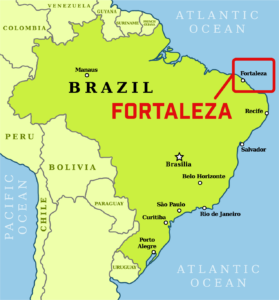
Haystack is designing and installing the signal chain for a new NASA radio telescope in Fortaleza, Brazil.
Frequently Asked Questions (click to expand/collapse)
- Whose telescope is this?
The new radio telescope is being commissioned by NASA’s Space Geodesy Project (SGP). The SGP radio telescopes are also part of the International VLBI Service for Astrometry and Geodesy (IVS) network, which includes VLBI telescopes around the world. - What’s a radio antenna/telescope?
Radio antennas, sometimes called radio telescopes, are large dishes that collect information in the radio portion of the electromagnetic spectrum. Everything in the universe emits energy, and radio science examines radio waves from objects in space, such as quasars, to learn about space. We also use radio waves in a technique called Very Long Baseline Interferometry (VLBI), that lets scientists precisely measure some interesting properties of the Earth and how they are changing. - Why is the new telescope going to be in Brazil?
Most of the NASA radio telescopes used in VLBI work are located in the Northern Hemisphere. Fortaleza has an existing observatory at this location, which makes it easier for the new dish to be installed and operated. Plus, its location in the Southern Hemisphere will improve the quality of geodetic data products obtained by the NASA radio telescope network. - What is Haystack doing for the new Fortaleza telescope?
MIT Haystack Observatory has built several signal chains for NASA’s radio telescopes, and will be building the signal chain for Fortaleza as well. We’re really excited about this project and can’t wait to see the telescope ready to go! - What is a signal chain?
In essence, the signal chain is the heart of the radio telescope: its non-metal parts. That is, it’s all the electronics. The signal chain includes all of the components necessary to detect and convert the incoming radio waves into digital recordings that can be further processed and analyzed by scientists. You’ll learn more about this as the building of this signal chain is completed and described in this blog. - What makes this network the “next generation” of radio telescopes?
VLBI is a very well established technique: it has been in use for decades. The IVS and its member organizations such as NASA have designed the VLBI Global Observing System (VGOS) with updated and improved modern technology, such as smaller, faster-slewing antennas and a broadband signal chain to get the best data via VLBI. Fortaleza will be the latest NASA VGOS radio antenna, alongside others in Texas, Hawaii, Maryland, and right here in Westford, Massachusetts.
LATEST UPDATES
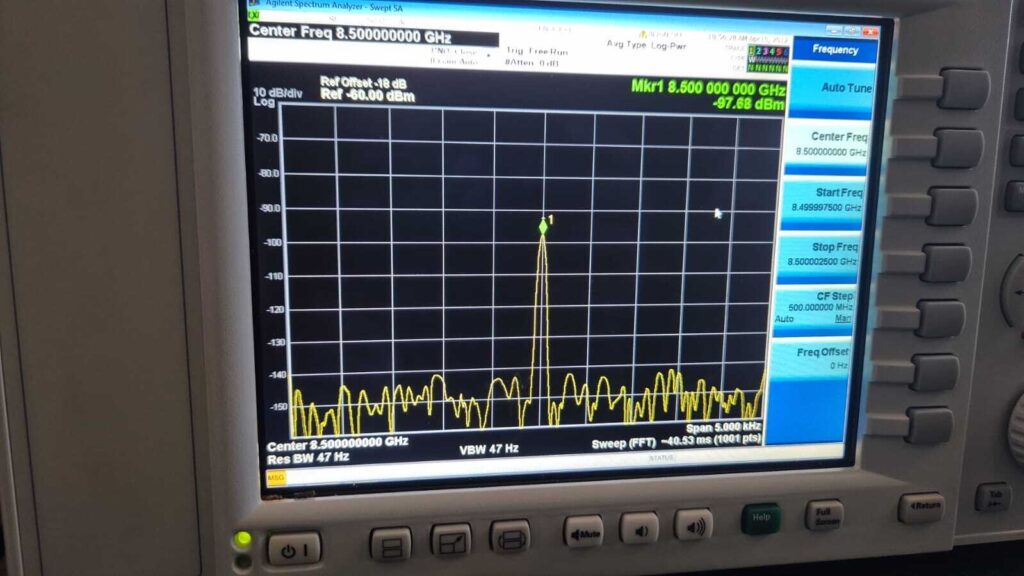
JANUARY 7, 2026
HAPPY NEW YEAR! We are also celebrating the arrival of the CDMS in Fortaleza and, excitingly, its successful bench test in the hands of our colleagues in Brazil. Congratulations to all on this milestone equipment test!
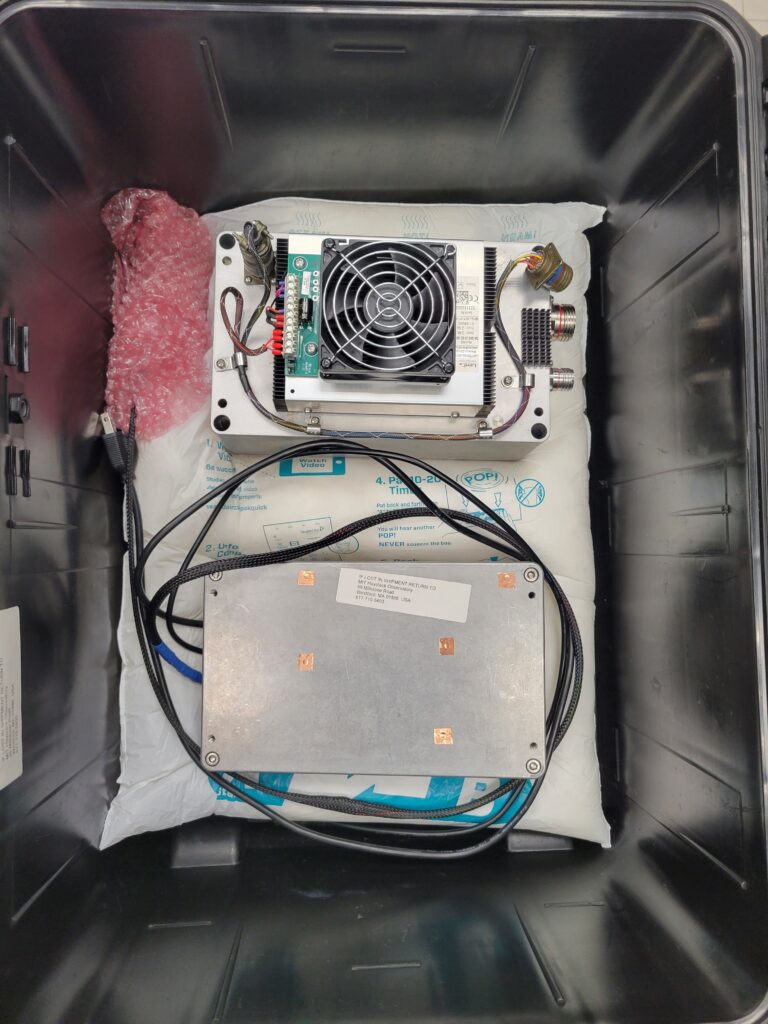
DECEMBER 3, 2025
An update on the Fortaleza installation and ongoing refinements to the new system: the CDMS took a little side trip back to Haystack’s Westford engineering laboratory for some repairs, which are now complete. It’s now awaiting pickup for its journey home to Brazil. Boa viagem, FGO CDMS!
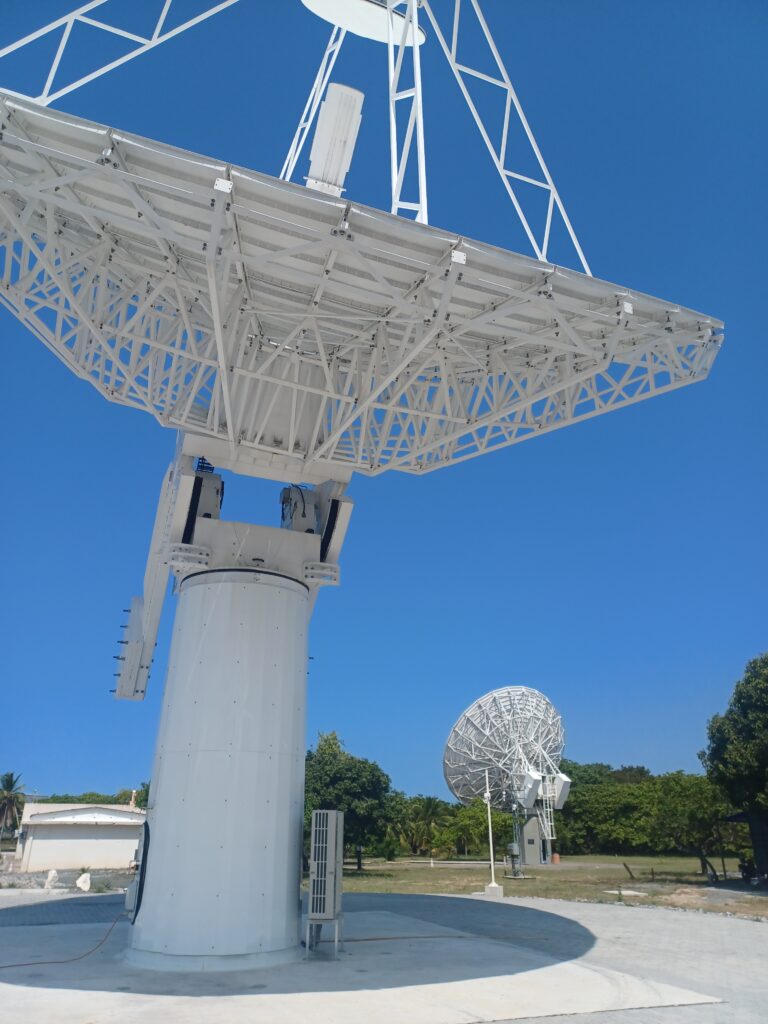
OCTOBER 22, 2025
BIG NEWS: The new Fortaleza radio telescope has achieved First Light! The Fortaleza and Westford telescopes made a 15-second observation of the quasar 3C371. Haystack Observatory correlated the datastreams from the two telescopes, and detected a strong signal in all four frequency bands and both polarizations. Congratulations to all the teams who contributed to this major milestone, engineering, installation, training, science, and of course our friends in Brazil who have been working tirelessly on getting things up and running.
Up next is to finalize the installation of the CDMS, described last October: “The CDMS, developed by MIT Haystack Observatory, aids in determining instrumental delays in VGOS antenna systems, including Fortaleza. The system calibrates for cable delays, signal phase, and signal amplitude by incorporating an active picosecond cable delay measurement capability, injecting a 5 MHz calibration and a switched noise signal for post-processing corrections.”
OCTOBER 2025: We are mourning the loss of our dear colleague Tony Bettencourt, who passed away earlier this month at a very young age. He is greatly missed.
OCTOBER 8, 2025
The Haystack team spent the last bit of time tidying up installation and configuration with a healthy dose of troubleshooting, but also training our already experienced Fortaleza colleagues on this new equipment. The intensive training included, for instance, a full day of practice on the backend systems, specifically going through the path of RF to IF to VDIF to recording to prepping for e-transfer. Haystack staff provided detailed explanations of the equipment, swapping of spare systems, and how data is stored and pulled together for e-transfer. Training also included (amongst many things!) front end information, how to debug the phase calibration system, how to disassemble and reassemble the front post-dewar system to get to the VDAQ, and VDAQ configuration and reprogramming/replacement. Documentation has been updated for future reference as well. Photos below include both the installation and training teams.
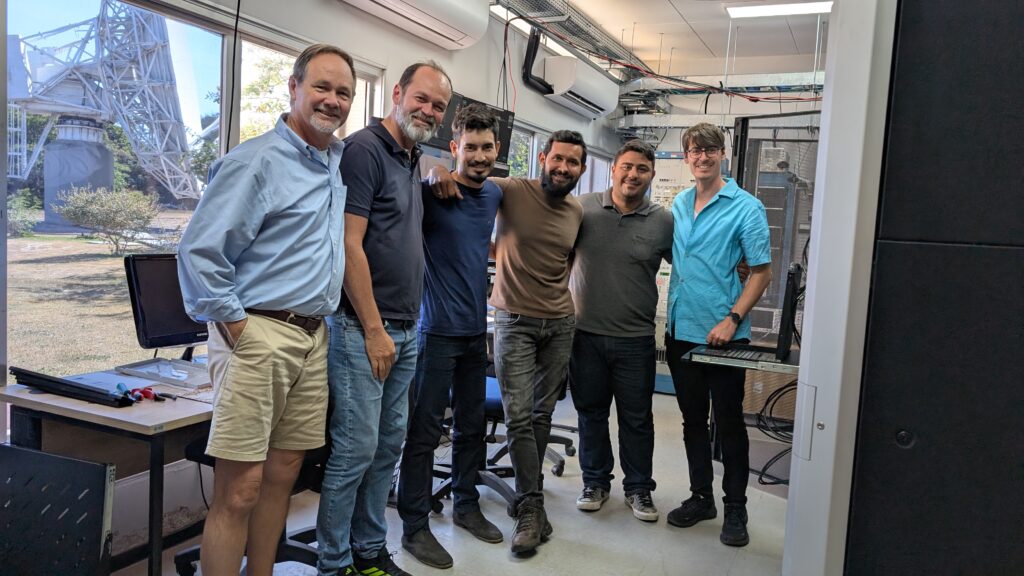
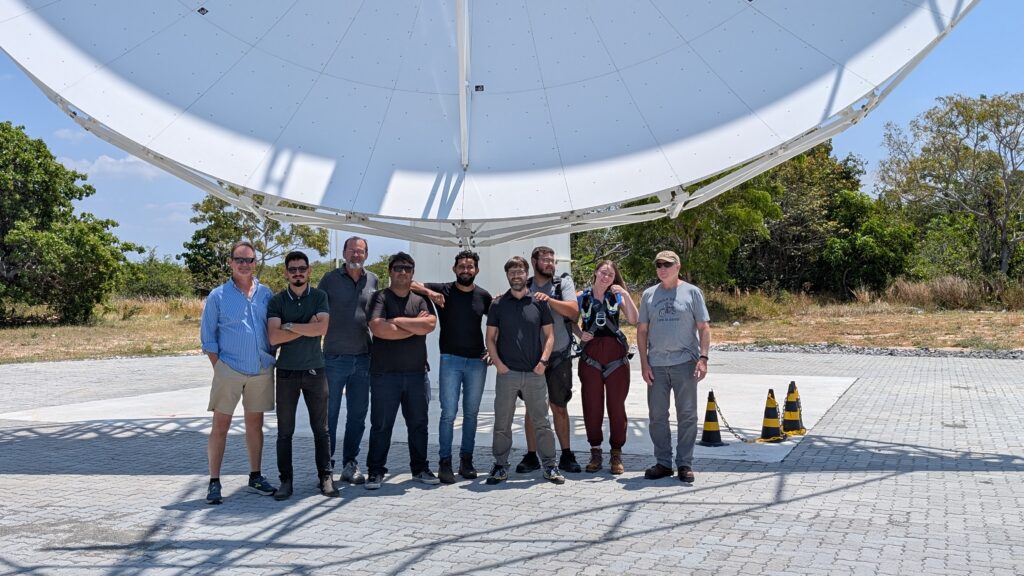
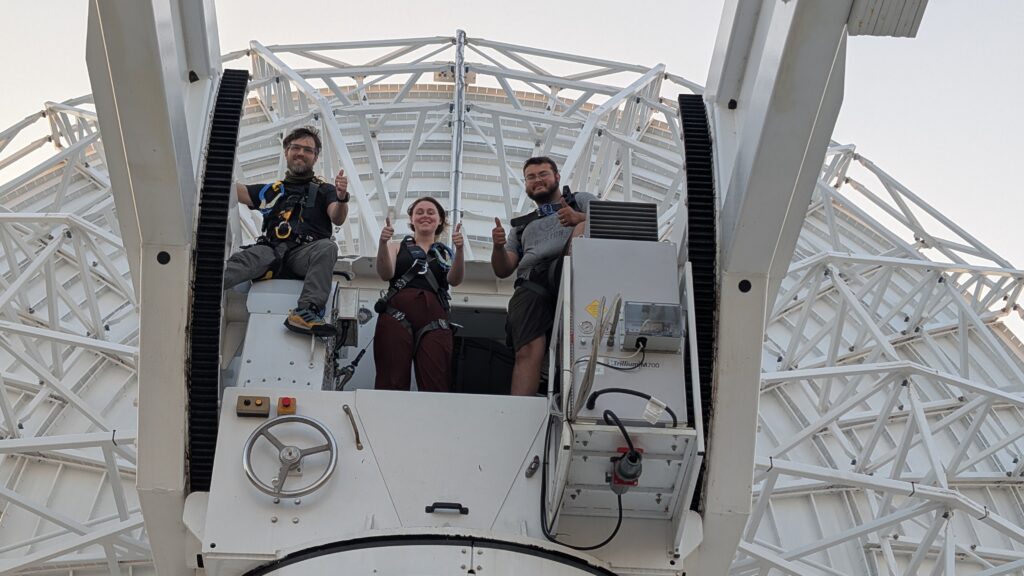
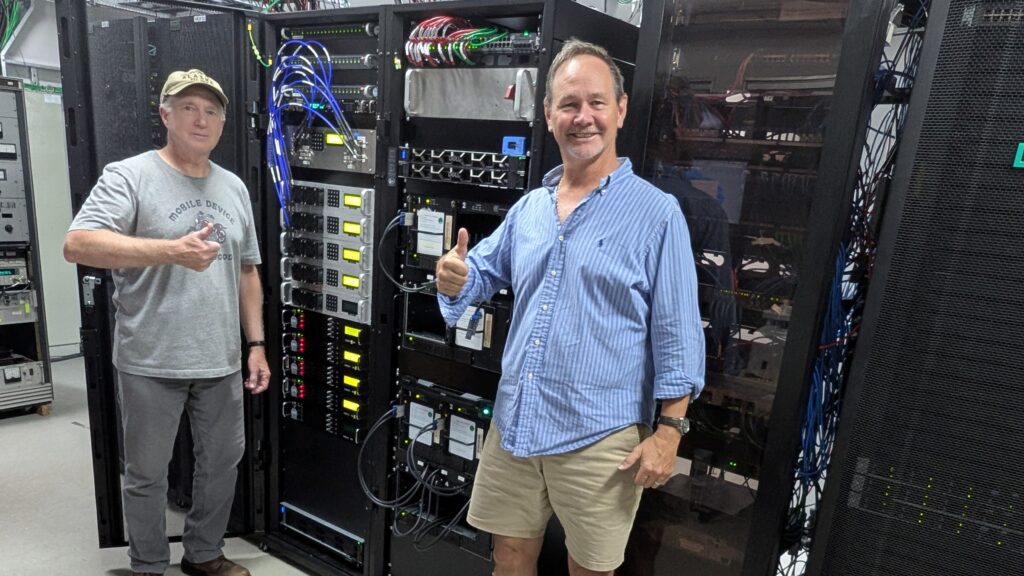
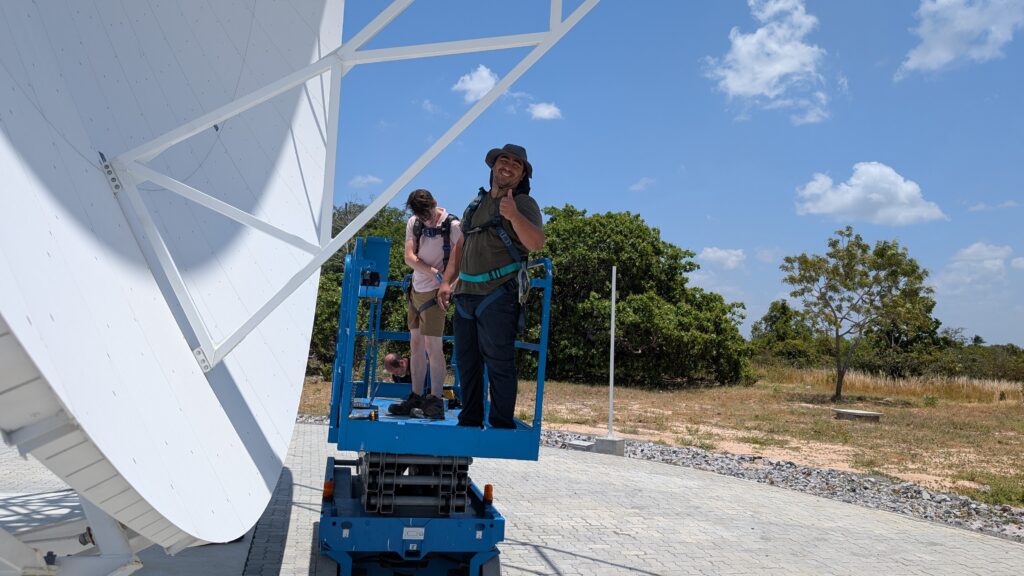
SEPTEMBER 24, 2025
Steady, ongoing progress from the Haystack and FGO installation teams continues. Some highlights, shown here, include the positioner installation and testing and the successful lift of the M700 compressor. A couple of focus areas now are training (teaching troubleshooting procedures, removing and reinstalling the payload, etc.) and completing full system integration with the field system. The teams continue at a fast clip of installation milestones like these.
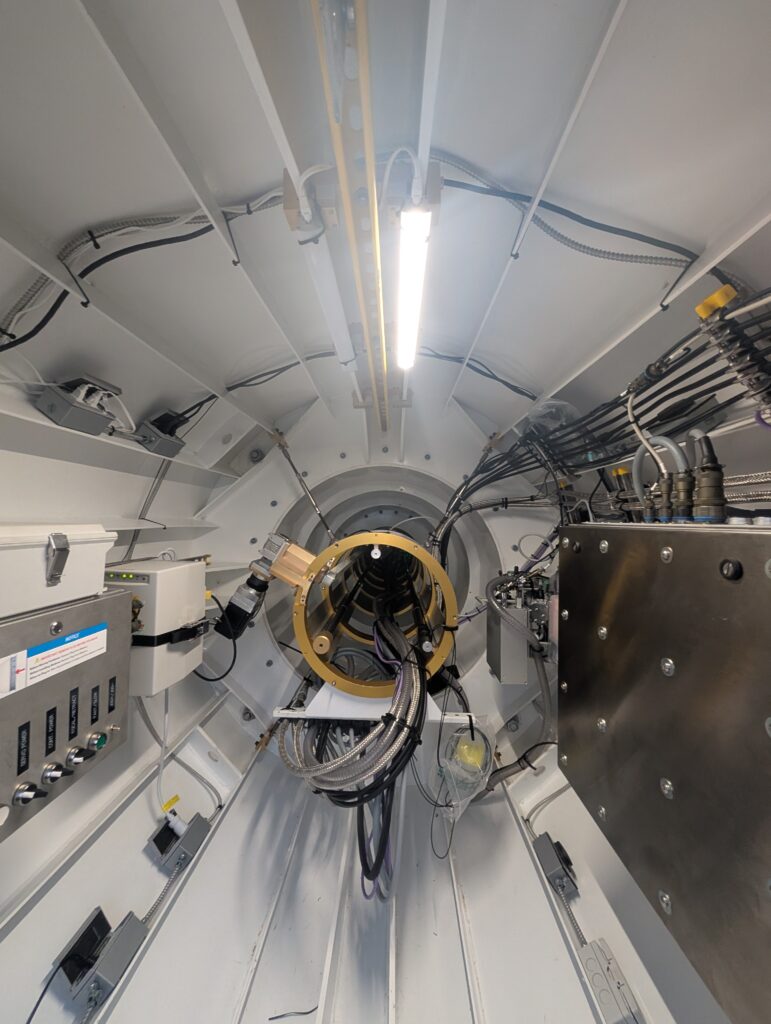
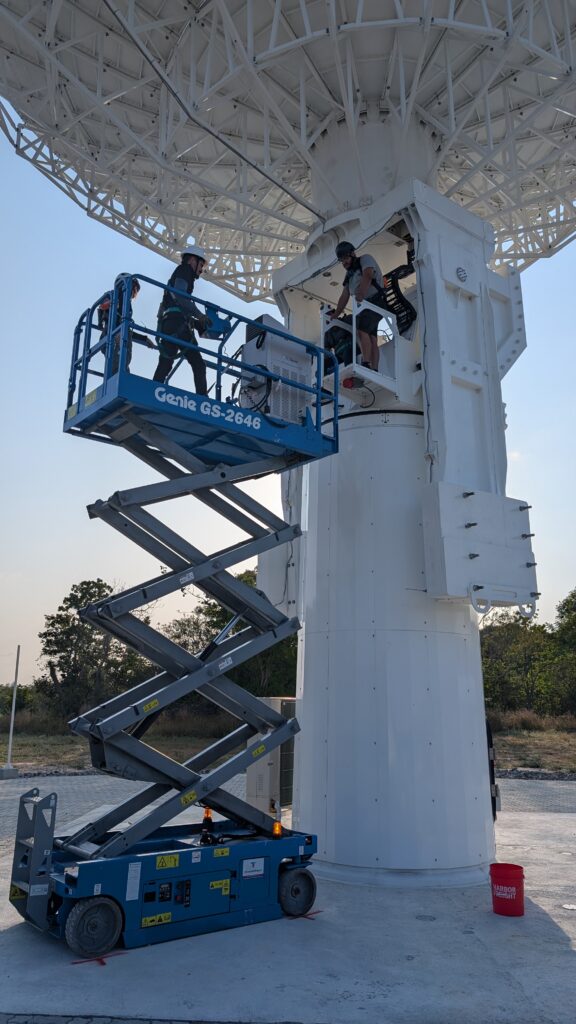
SEPTEMBER 12, 2025
GOOD NEWS, EVERYONE! The signal chain components made it through some incredibly interesting routes and the throes of customs to Fortaleza, Brazil (the CDMS is bravely bringing up the rear). And so did our engineering and installation team members.
Even in beautifully distracting Brazil, the team is getting an intense amount of work done on the installation. Updates include long lists of achievements, which at this point are pretty heavy on fiber, coax, and networking cable pulling, along with initial installation and powering-up of the basic components of the signal chain, such as getting systems into the racks and talking to each other. They’ve overcome a few small challenges, and both the front-end and back-end teams are making rapid progress—UDCs checked, temperature sensors up and running, the Network and Electrical Distribution box (or NED, affectionately) is mounted, R2DBEs running, and countless cables of various types have been run into the control room and pedestal, amongst many other completed steps.
Thanks to the never-ending requests for photos, we even have some installation images to share, and more to come!
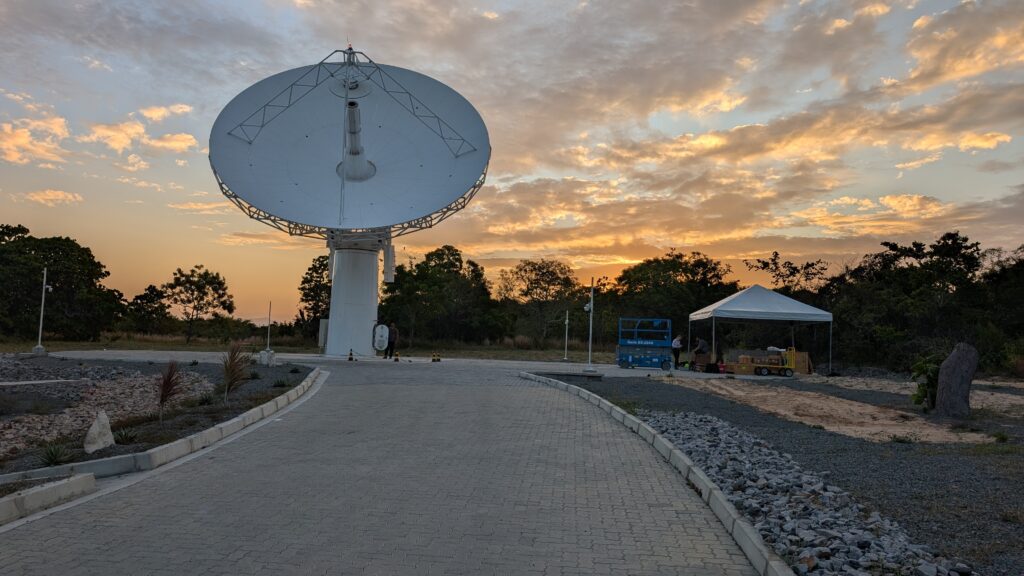
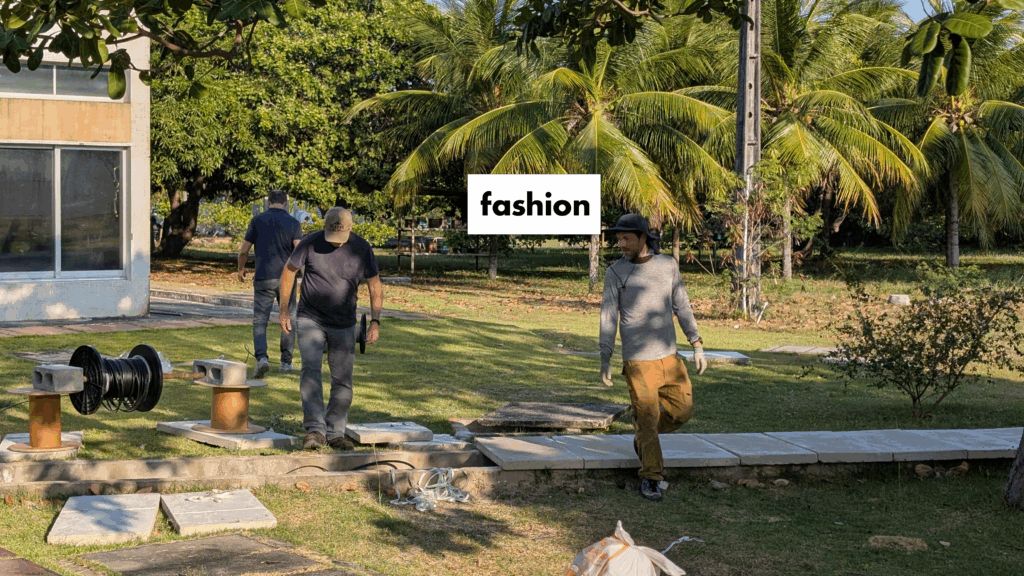
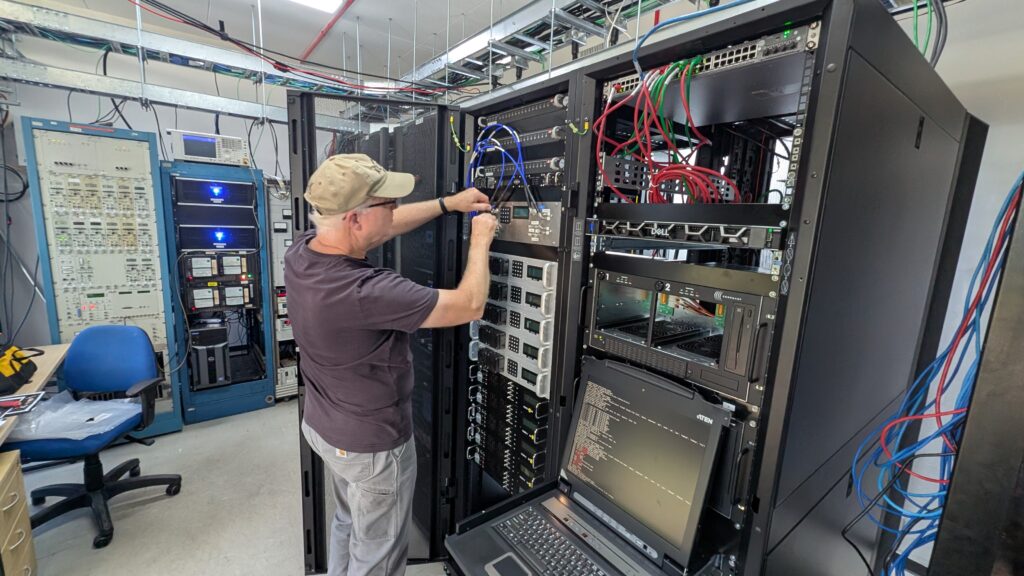
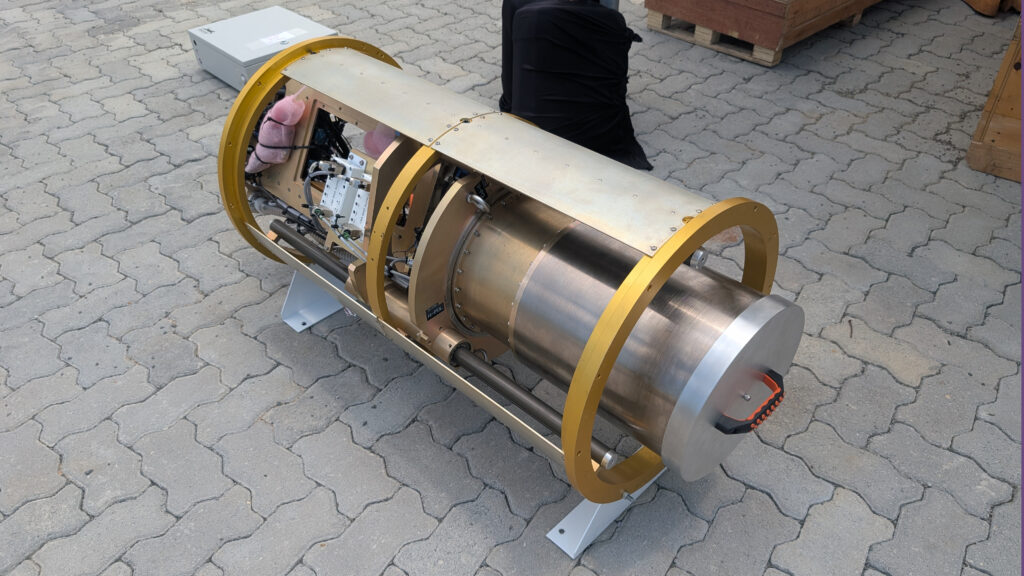
AUGUST 20, 2025
NEXT STOP: BRAZIL! Shipment 1 of 2 is on its way to Fortaleza! And as of this update, it’s actually in Brazil already, and weaving its way through customs approval. (The compressor is about to follow!) We look forward to hearing that installation has started and will send updates once our engineering team is on site with our Fortaleza colleagues. Thanks to the Haystack teams for managing an intense and complicated shipping process and getting this out the door successfully!
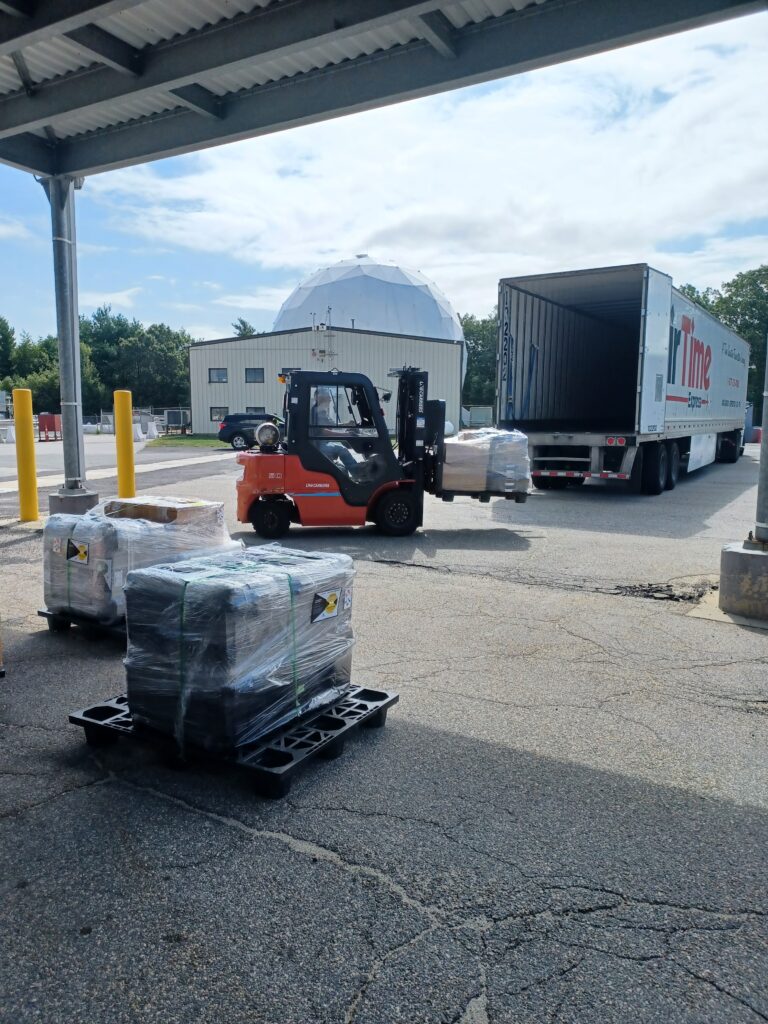
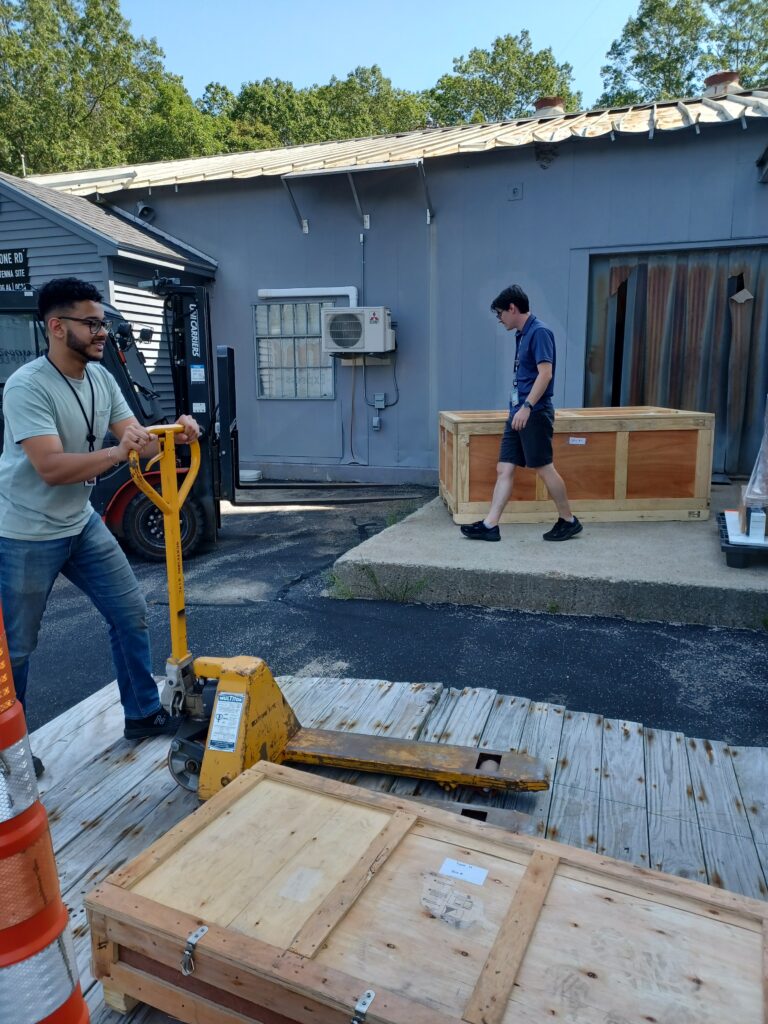
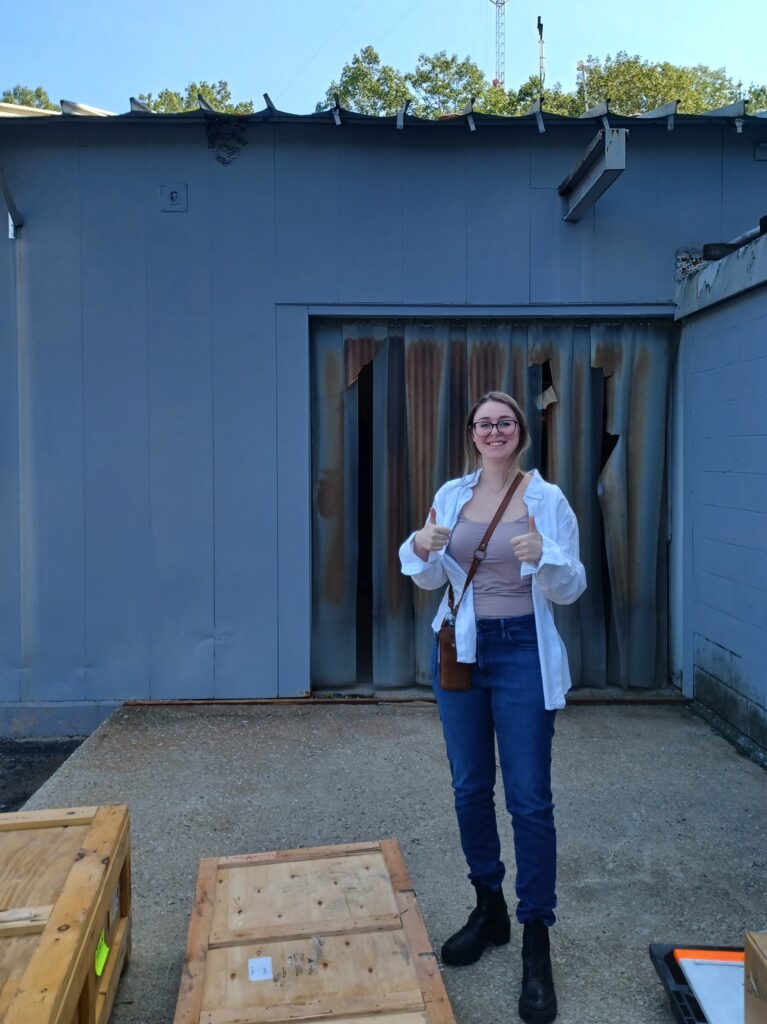
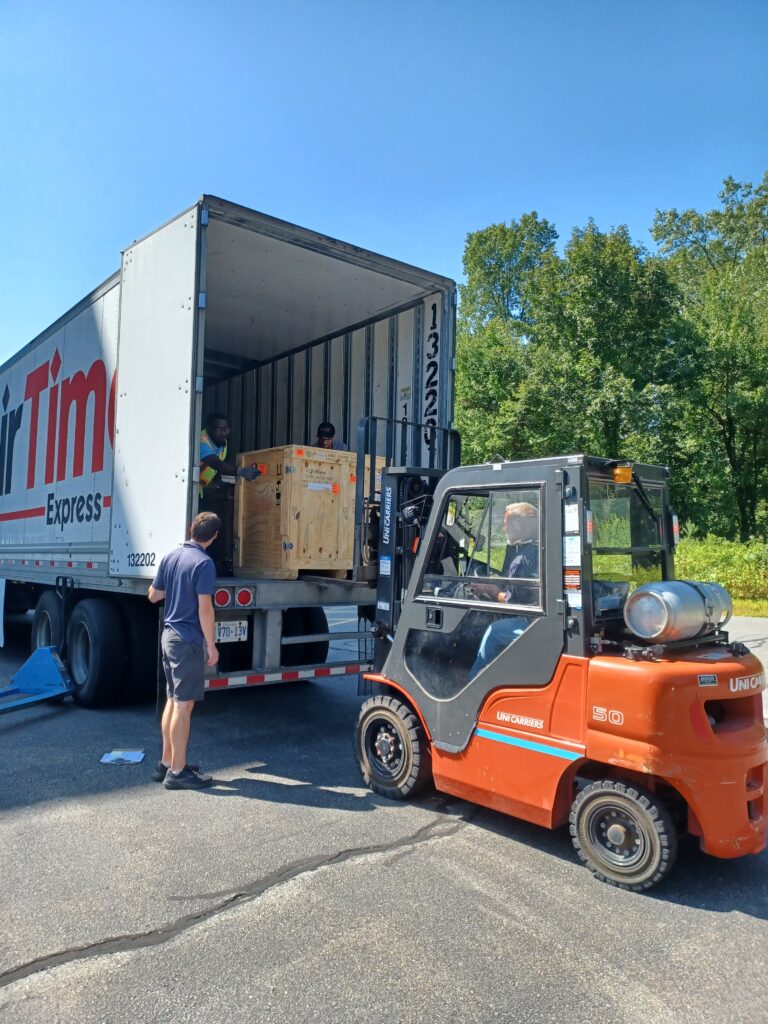
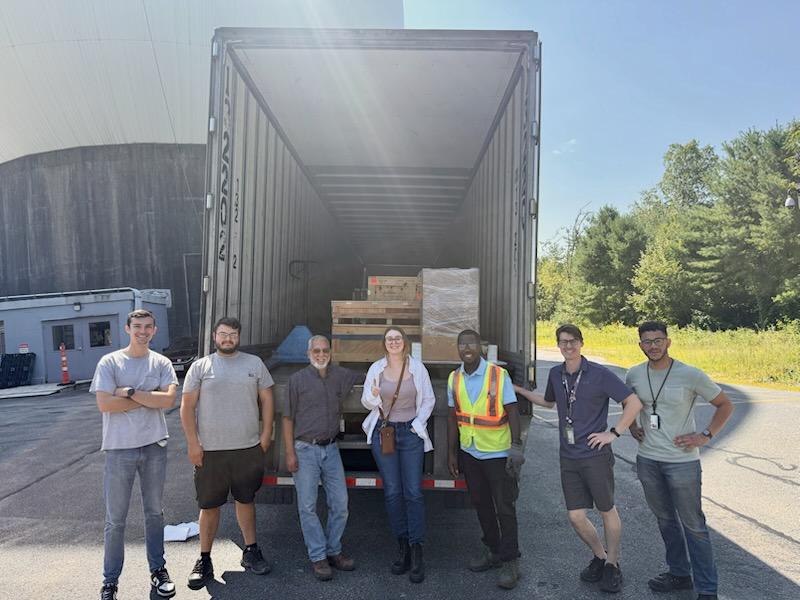
JULY 23, 2025
GOOD TO GO! The signal chain packing is complete and ready to go, all palletized and awaiting pickup. The shipping docks are full of mysteriously labeled boxes, sturdy crates, and intriguing plastic-wrapped containers—a few instances of which are shown here. Bon voyage!
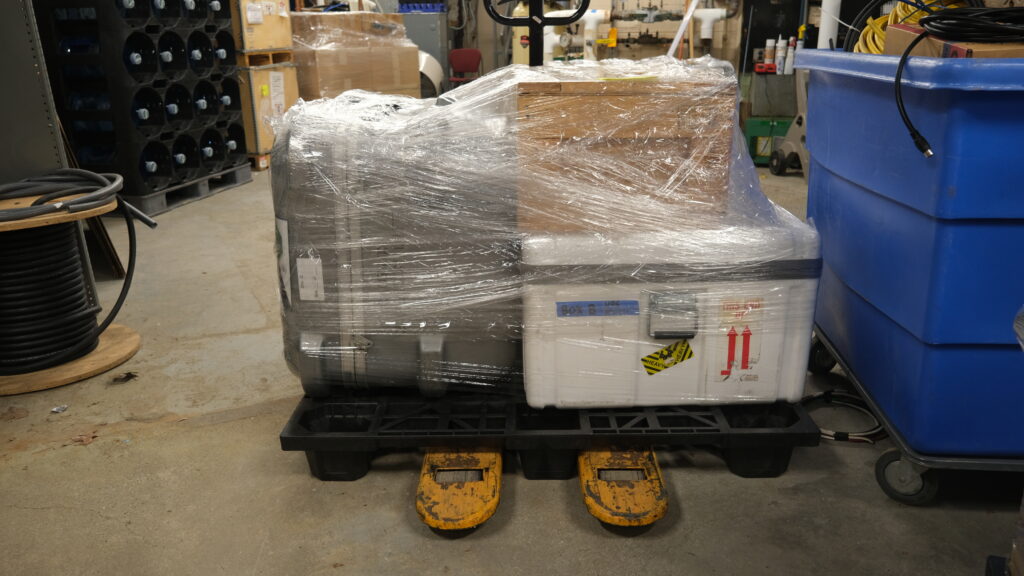
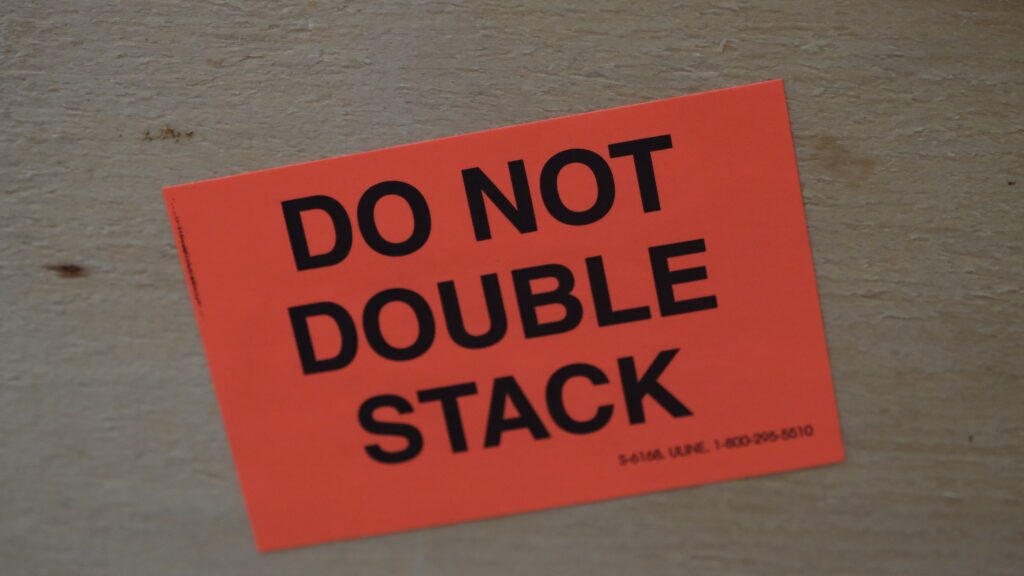
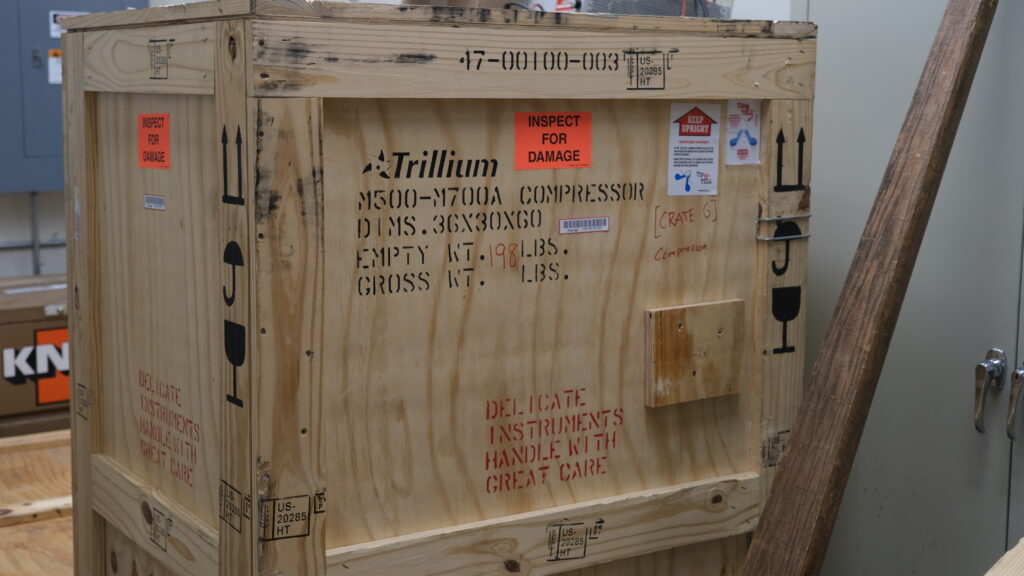
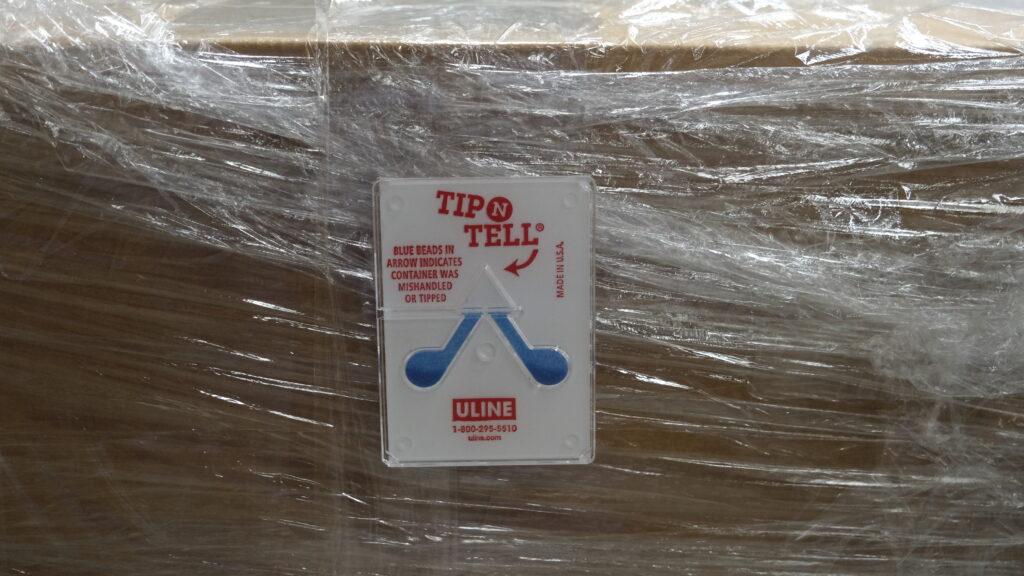
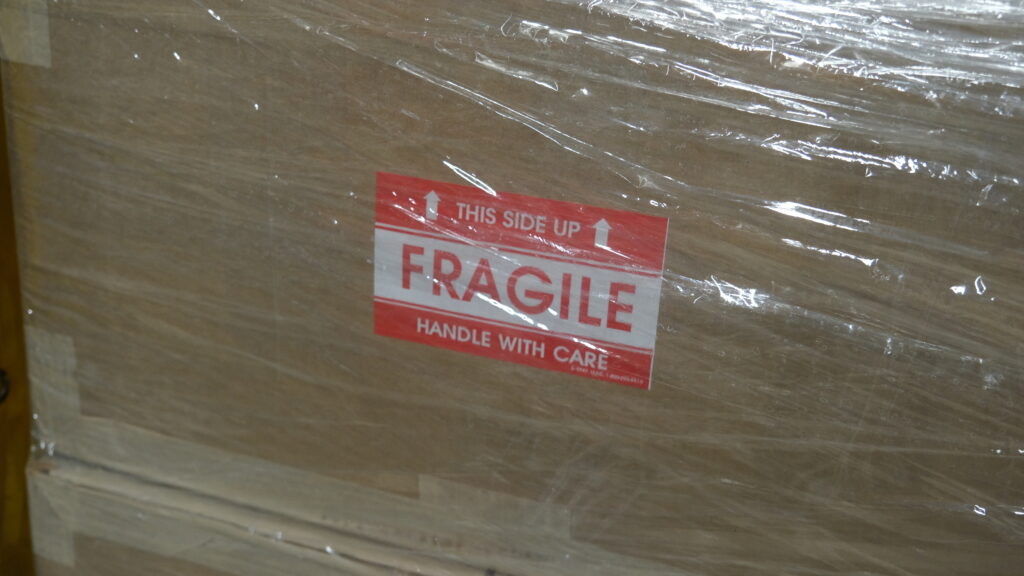
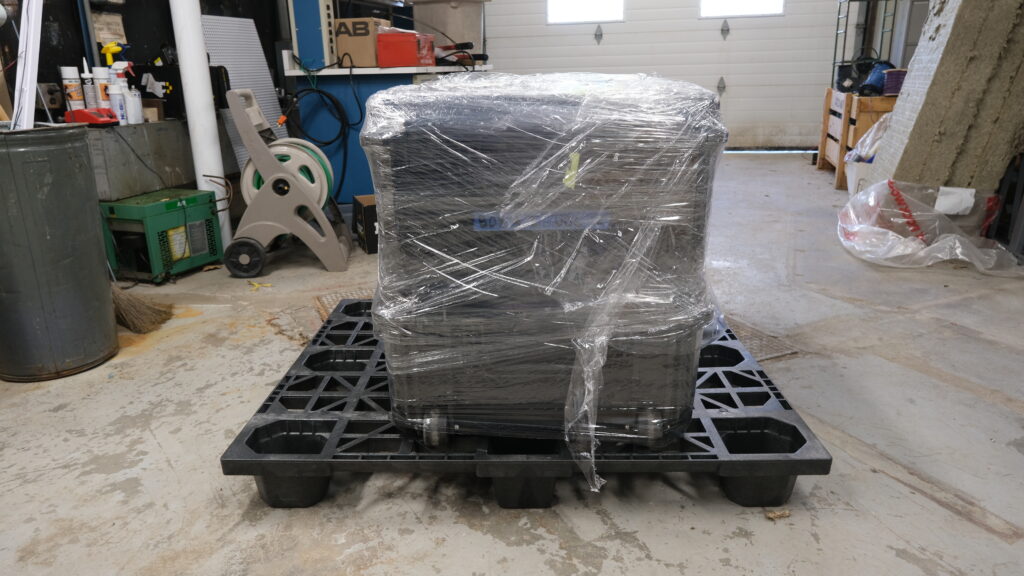
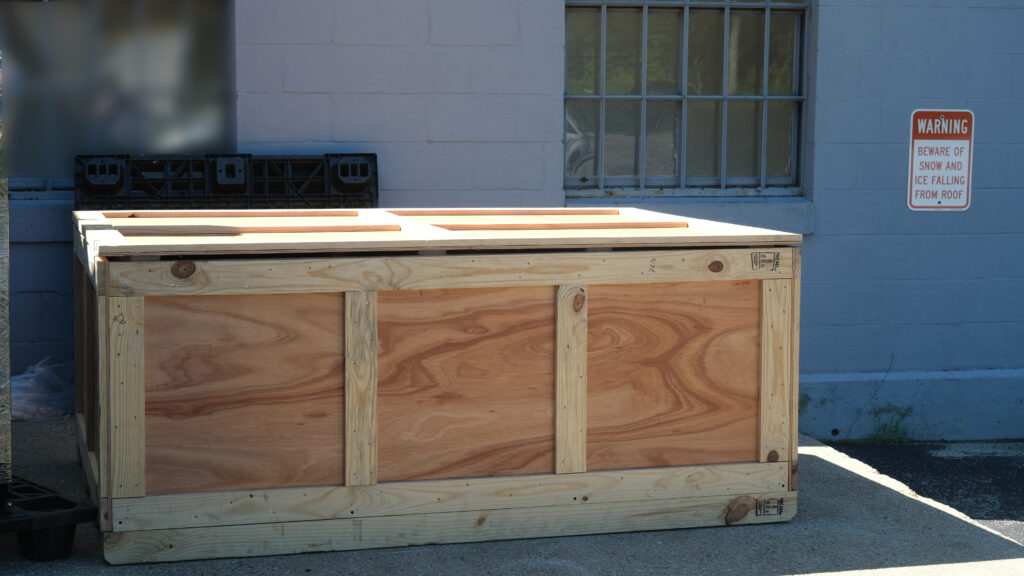
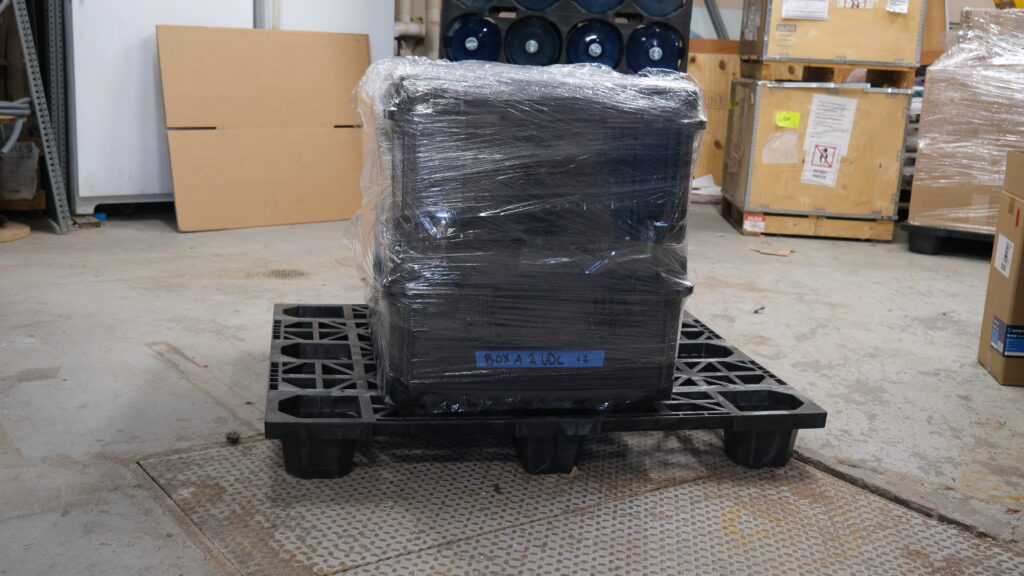
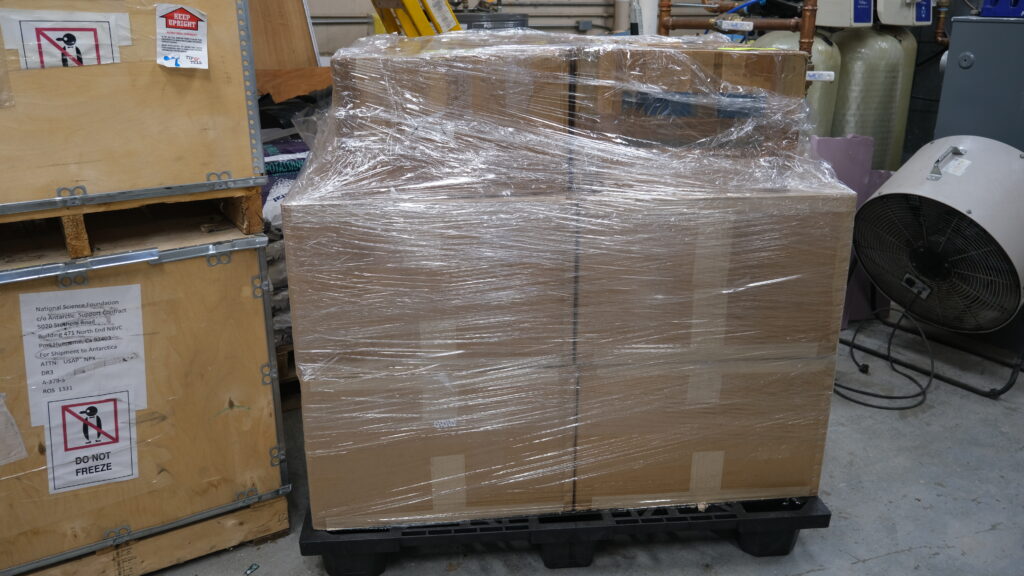
JULY 16, 2025
DESTINATION: BRAZIL! The signal chain is packed and nearly ready for shipping. (Note that we don’t just build the signal chain and throw it in a box: we actually build custom wooden containers as well.) Here you see some of the FGO components about to leave the shipping staging area at the Westford laboratory, with technicians Tony and Abiel (and our shipping manager, Don, and others). The next thing to come is “palletization,” or packing of the many boxes onto pallets for transportation—from Haystack all the way to Fortaleza.
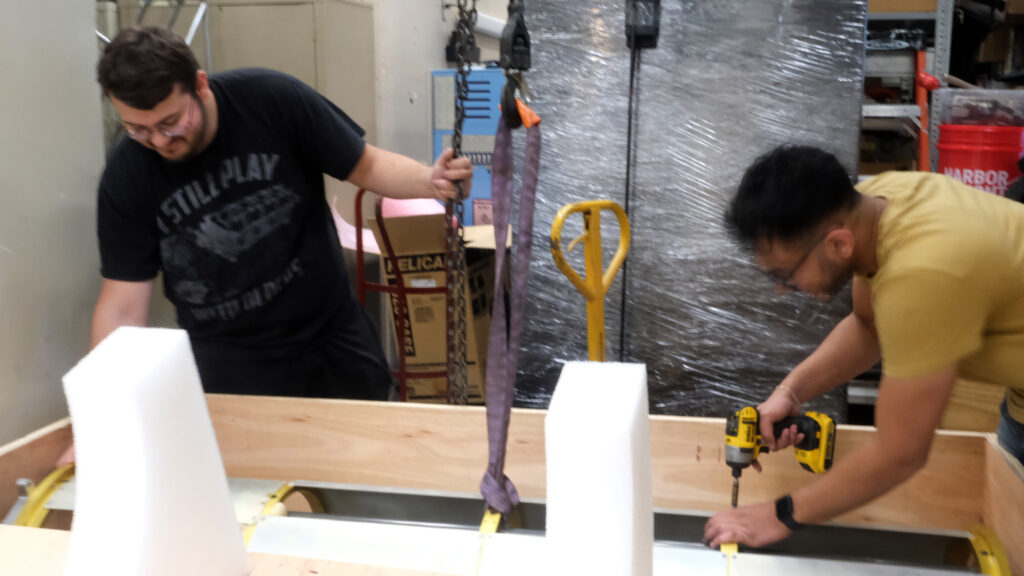
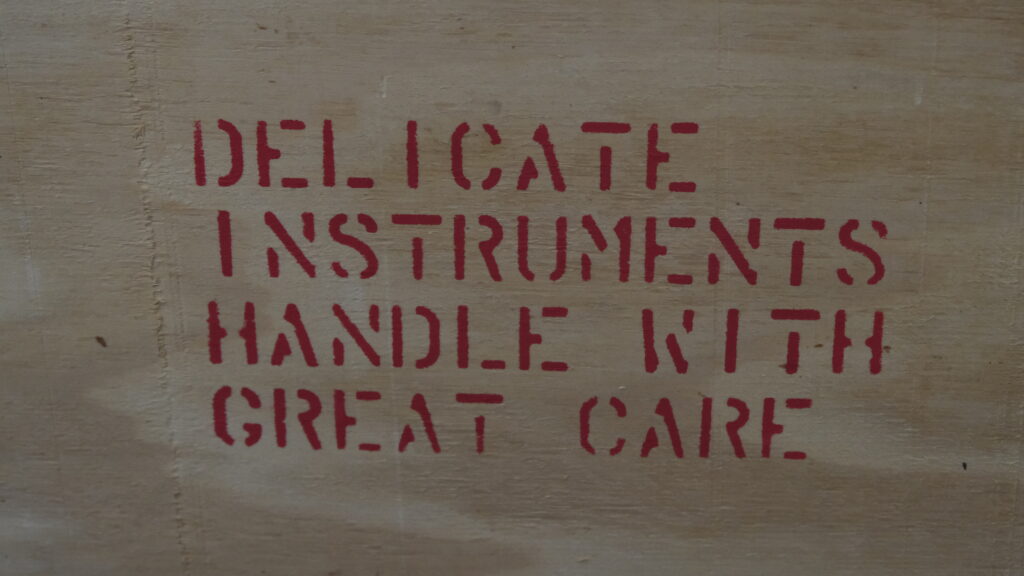
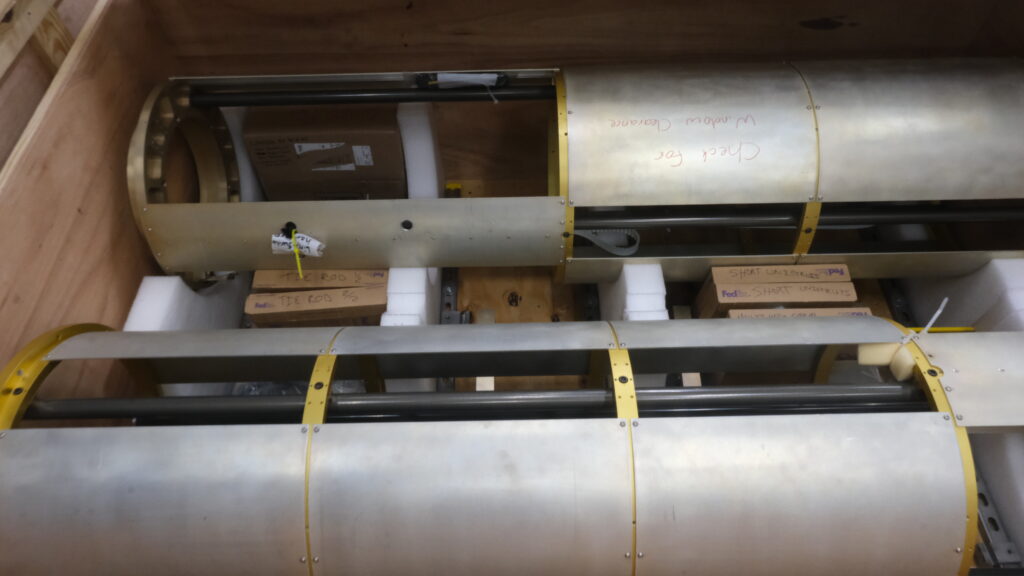
JULY 2, 2025—MILESTONE: PRE-SHIPPING REVIEW (PSR)
JUNE 11, 2025
PSR update: the build team has successfully completed the fabrication, integration, and testing of the FGO signal chain, and has also assembled a documentation package containing a slew of documents and presentations that describe the incredible engineering detail of how the signal chain meets requirements, and is therefore ready to proceed to the Pre-Shipping Review (PSR), which is scheduled for July 2. We are looking forward to going over the many details with our NASA colleagues!
JUNE 4, 2025
The PSR approaches! PSR stands for Pre-Shipping Review, and it is a significant milestone in the build calendar. It is coming up next week and teams are working relentlessly to make sure everything is in literal ship-shape condition.
These are a few of the build team members on the clock for Fortaleza: from the Westford engineering laboratory, Alex, Tony, and Abiel. You’ll see some others featured here soon as well—today, a few were lured out into the sunshine after laboring over the signal chain.
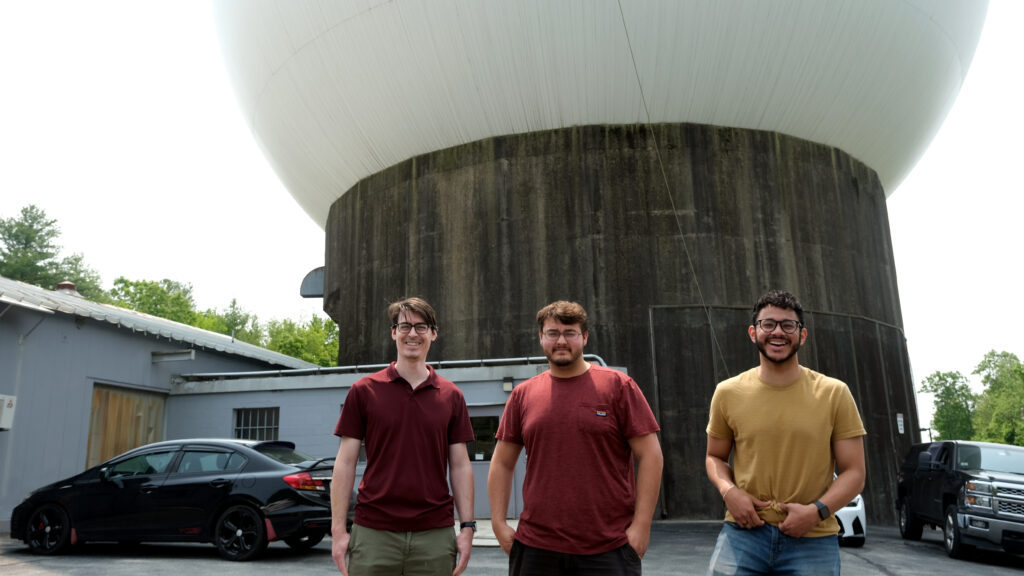
MAY 21, 2025
More crucial testing cycles: in these photos, the engineering team is checking the hot/cold or Y-factor measurements of the assembled signal chain. The engineers are checking the receiver system temperature with both liquid nitrogen (left) and ambient loads, or room temperature (right); what they determine from this is how much “noise” the receiver itself adds to the measurements. Successful results just added!
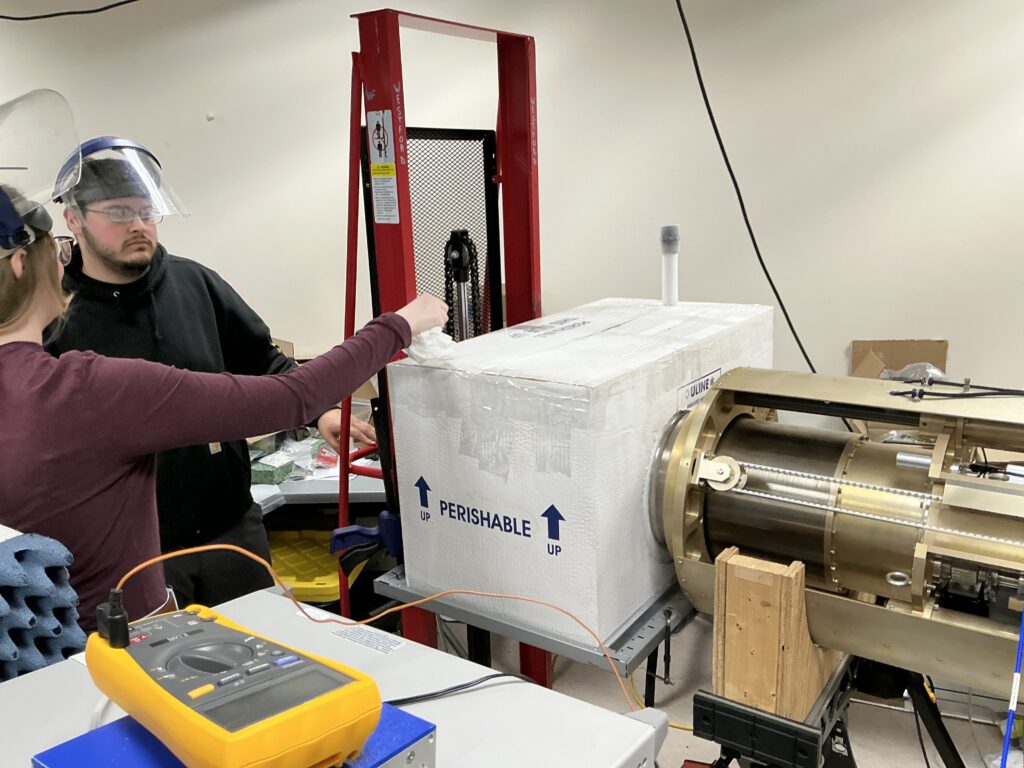

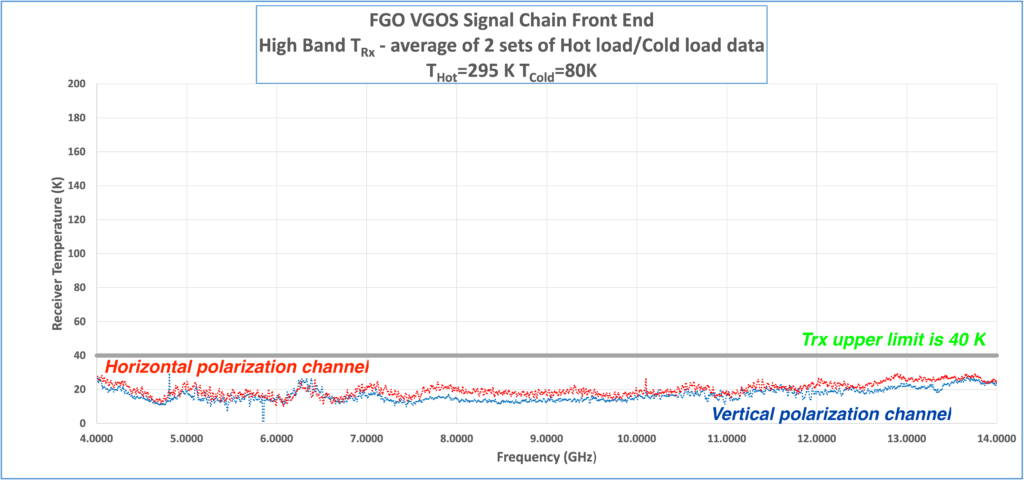
MAY 14, 2025
We often talk about our extensive testing procedures; we don’t always show why it’s important to perform such vigorous analysis during the signal chain build procedure. Today, here is an example of what we could catch and what we fix here so that it doesn’t happen out in the field.
A reality of undertaking this type of cryogenic, GM cycle helium refrigeration–related engineering is the necessity of burn-in testing, where you essentially leave things running and look for issues to ensure they’re caught—and corrected—well before the ship date. In the first photo below, during a testing cycle we found a helium refrigerator badly contaminated with oil. The engineering team then worked through the weekend to make required repairs!
Notes from engineering: enthalpy stalling occurs in regenerative cryocoolers like the GM cycle when the enthalpy flow in the regenerator becomes imbalanced, preventing efficient heat exchange between the high- and low-pressure helium. This typically happens at very low temperatures (below ~10K), where the regenerator can’t effectively store or transfer heat due to limitations in specific heat or flow timing. As a result, the cooling power drops or stalls, limiting the refrigerator’s ability to reach or maintain cryogenic temperatures.
Our vacuum ion gauge for the receiver is now operational and reads a minimum pressure of 3×10⁻⁸ Torr, confirming significantly lower pressure than the detection limit of the Hastings DVAC-6 tube. This new development has been successfully tested and validated, demonstrating that our actual system pressure is well into the high vacuum regime. Achieving this pressure improves our ability to cryopump light molecules like hydrogen and helium, and the gauge also provides early warning of vacuum degradation, allowing us to respond proactively to leaks or contamination.
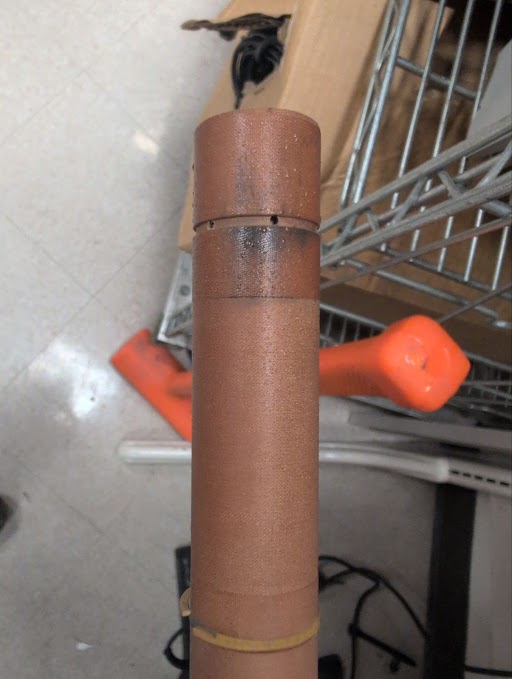
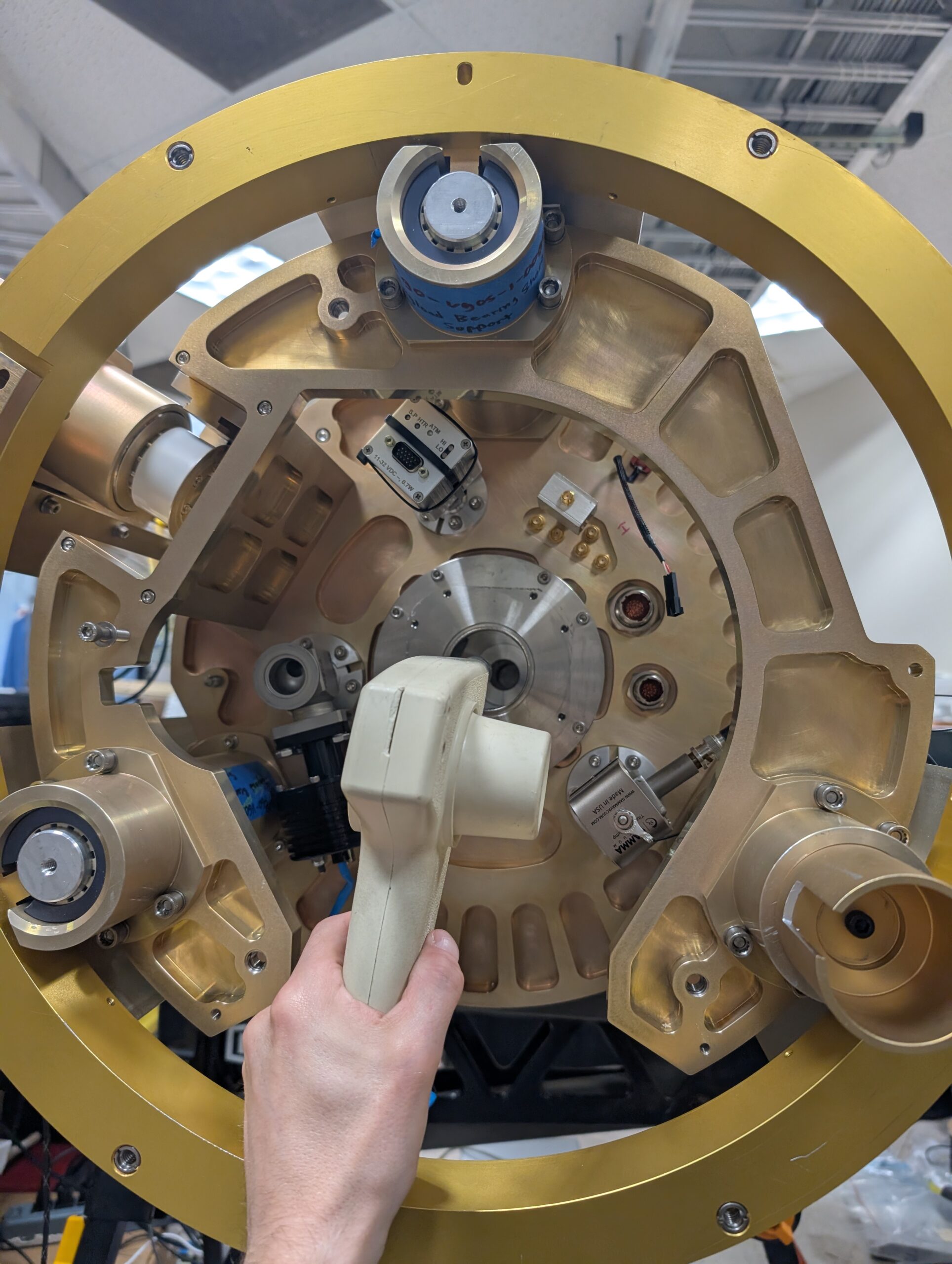
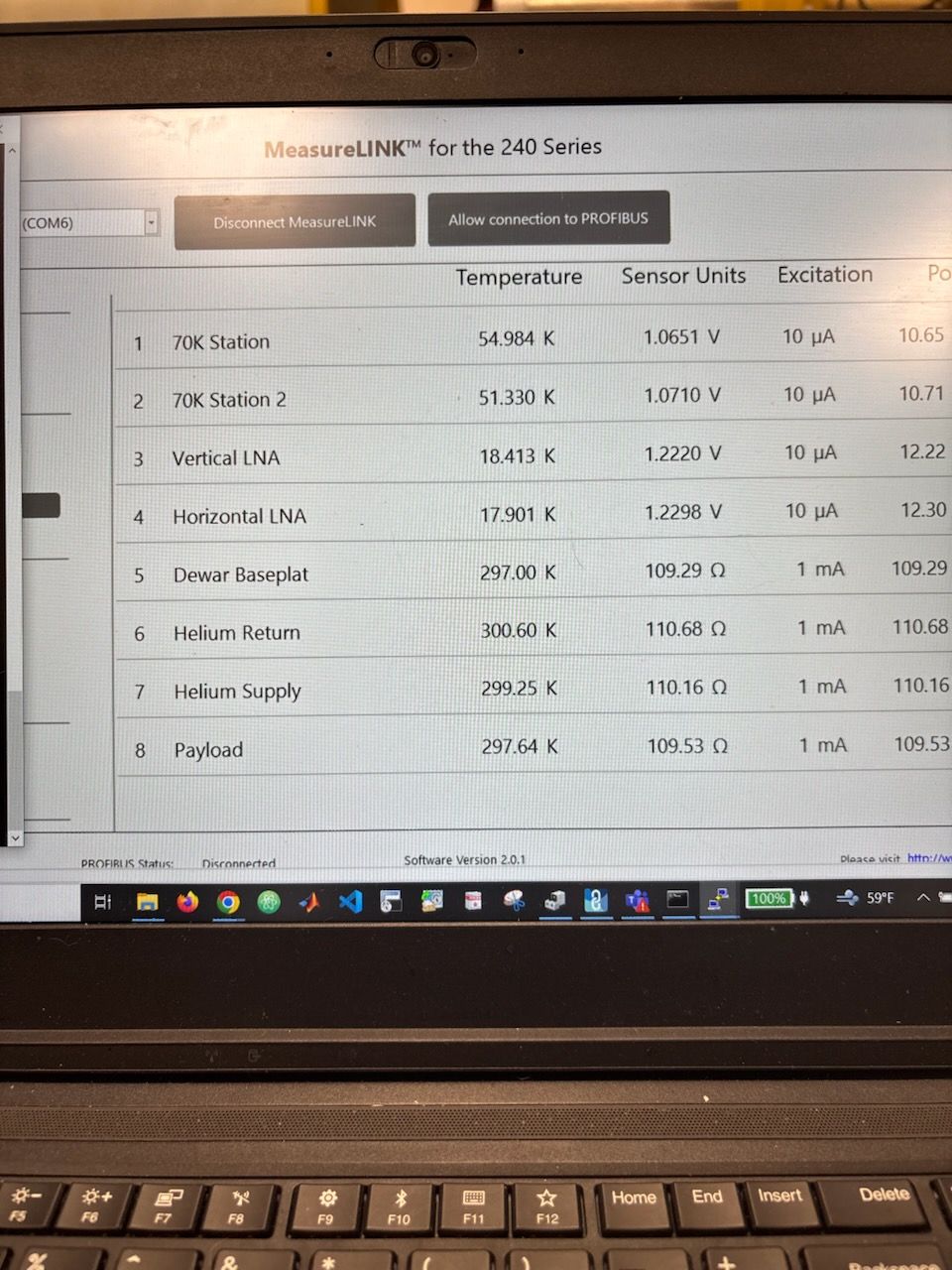
The images here show oil in the cold head, cylinder warming in preparation for the new refrigeration core, and temperatures of the receiver after replacement. Alternative caption: A long but successful weekend!
MAY 6, 2025
THIS WEEK AT HAYSTACK: The 13th IVS Technical Operations Workshop is being held at Haystack, with many attendees from around the world! One of the stars of many talks this week is the Fortaleza signal chain in all its glory. Work continues behind the scenes, but the signal chain is significantly featured in numerous lectures during this conference—along with many other closely related radio science and VGOS subjects.
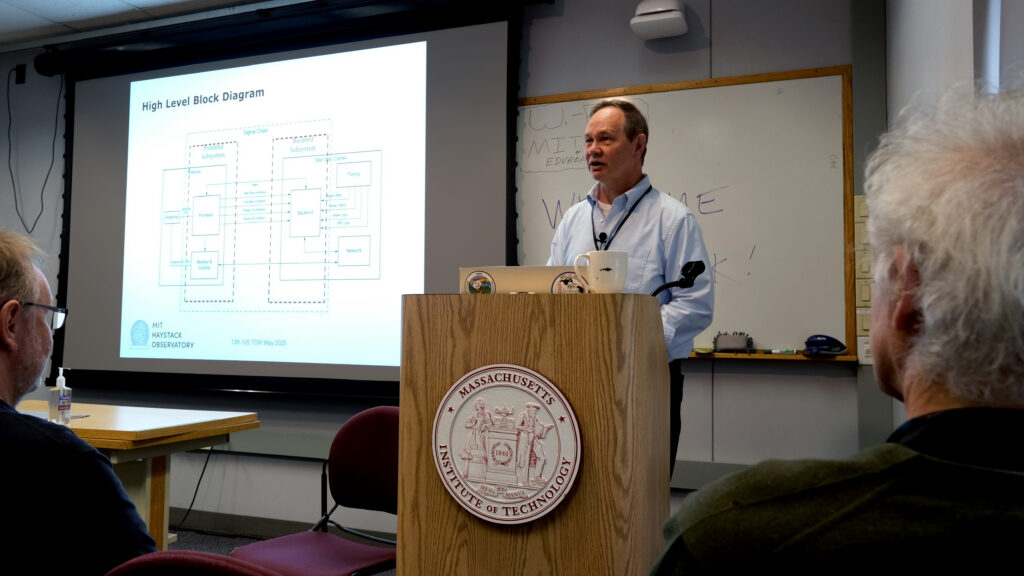
APRIL 30, 2025
The Haystack team is nearing completion of integration testing for the field system (FS) with the R2DBE (ROACH2 digital back end—the fourth-generation NASA digital back end, which converts the incoming analog signal to digital—see April 6, 2023, below). The integration of the R2DBE and the FS are currently going through the final testing phase before release to FGO; it means that the FS can now take advantage of features such as pcal amplitude reporting and Tsys measurements for pointing and observing. Unlocking the full capabilities of the R2DBE with this feature included intricate FPGA and server code updates. We’ll have more on this component update in an upcoming entry, and it will be made widely available shortly.
APRIL 23, 2025
The signal chain is coming together, and getting readied for shipping: more on this soon. One of the interesting pieces in the Westford laboratory today is the hub enclosure, a silver box crammed with essential parts of the Fortaleza antenna’s signal chain.
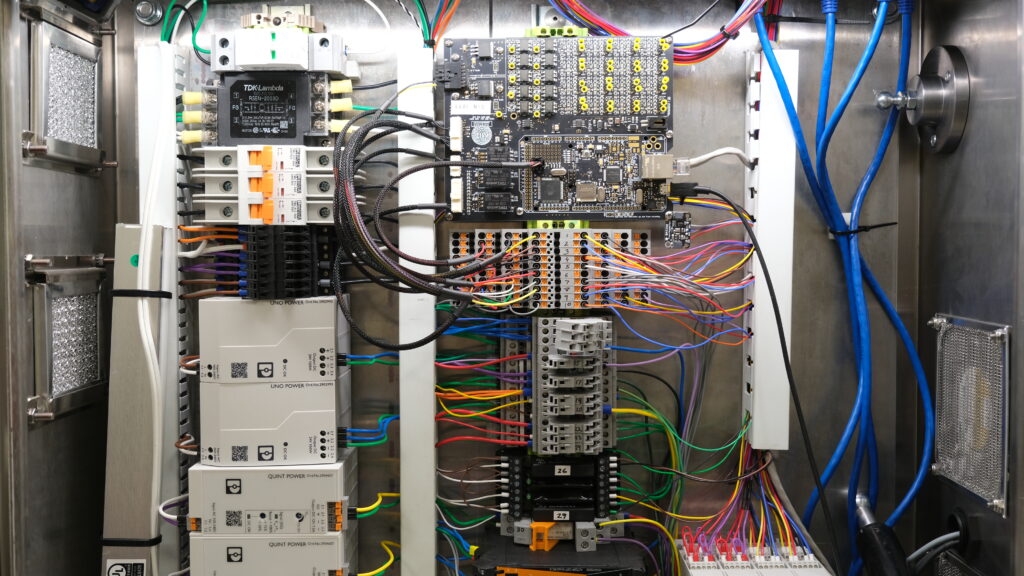
A partial list of components within or processes controlled by the hub enclosure: DC power generation and regulation for the cryogenic front end; cryogenic compressor control; vacuum system control; housing for the monitor and control infrastructure (MCI) server computer, back ion controller (helps maintain the high-level vacuum feature); network switch for power over Ethernet for the VDAQ board; actual VDAQ board; cryogenic temperature monitoring.
It looks like the engineers left a little space in the box over on the right, though!
APRIL 8, 2025
More testing in the Haystack laboratory! All sorts of things on the slab. Shown here is the phase calibration testing, or phase cal, or p-cal if you’re into the whole brevity thing.
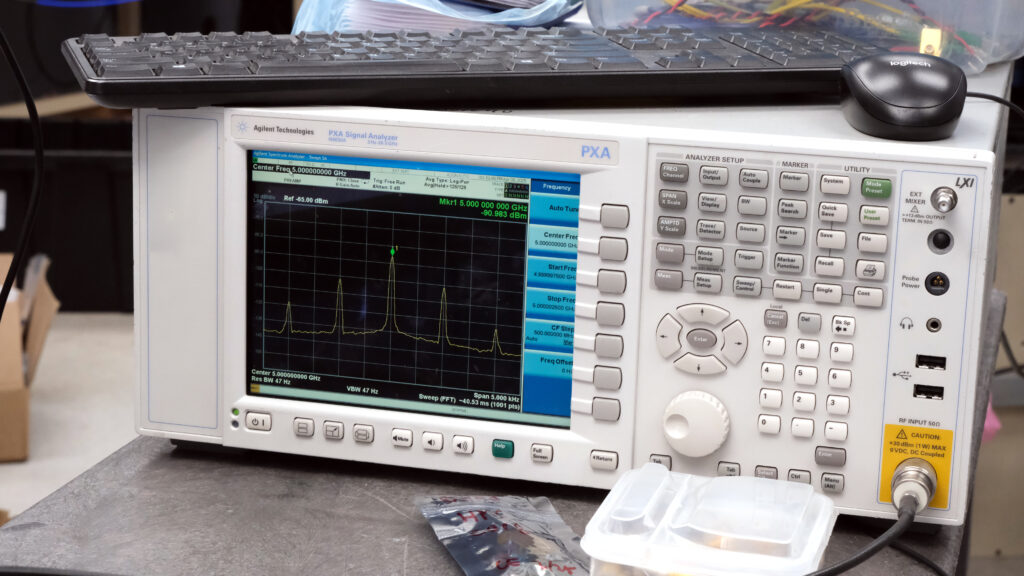
Phase calibration is a check on how the received signal is passing through the antenna’s signal chain electronics. The VGOS systems receive signals from distant quasars in four different frequency bands, and each of these bands takes a slightly different path through the signal chain—and they have to be kept in complete synchronicity through the chain. To ensure that the timing is perfectly accurate throughout, a tone is added to each band, and this allows the bands to be kept in alignment: this is phase calibration. So the p-cal testing ensures that the signal is making it through the signal chain properly and that the timing is absolutely correct.
APRIL 2, 2025
This week’s highlight: test-cooling the FGO receiver in the Haystack lab. With a set of monitors across the lab space, lead engineer Chris Eckert is bringing the front end down to temperature and making sure everything is in good shape. A couple of short videos provide some idea of the sci-fi sounds emanating from the lab during this test.
An explanation straight from the expert: “The engine behind the VGOS receiver’s extreme sensitivity is its helium refrigerator, which cools the feed and LNAs to temperatures below 20K. The receiver is designed to achieve these low temperatures while meeting the tight space constraints of the 12m antenna. One of the final integration tests in the instrumentation lab is a cooldown test that verifies not only that the cryogenic systems operate as designed and that the LNA, feed, and calibration couplers perform reliably at these temperatures, but also that critical components—such as the cryogenic temperature sensors, vacuum sensor, helium pressure sensors, helium lines, vacuum vessel (dewar), IR shield, multilayer insulation, IR filter, and Mylar vacuum window—are functioning properly. With this milestone successfully passed, the receiver will now be relocated to the Westford laboratory for final system integration, zero baseline, and liquid nitrogen testing.”
MARCH 19, 2025
Everything we build goes through multiple rounds of rigorous testing! We wouldn’t want to get things all the way to Brazil to find an issue at the last second. One of the trials this week including room-temperature testing of the frontend receiver, before they are cooled down to an impressive –430ºF (a.k.a. ~15 kelvin).
Shown here is the antenna feed horn, which collects energy that is received by the 12m dish and converts it into a tiny, oscillating electrical current. A carefully calibrated amount of energy is dispensed to allow engineers to measure the sensitivity of this, the most critical component of the signal chain: the low-noise amplifier (LNA). The coupler in the photos “injects” noise tones to calibrate the time it takes for a signal to propagate through the entire chain.
Everything is looking good! We hear it’s nice and warm in Brazil during the installation period, so people are looking forward to that after a long New England winter.
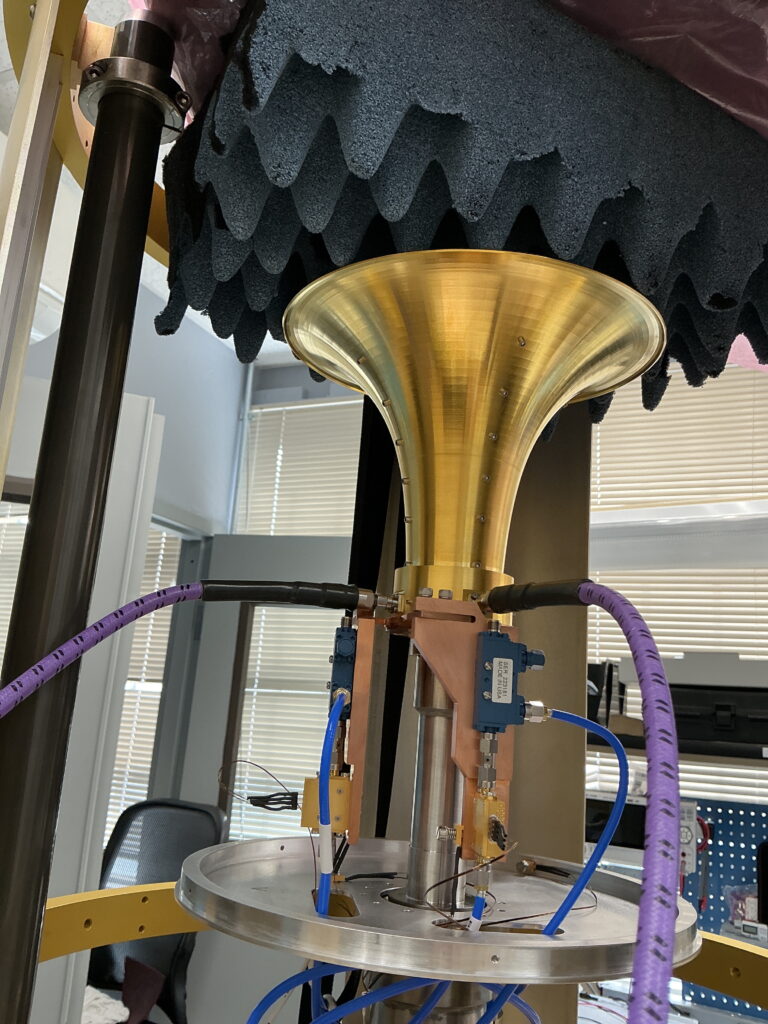
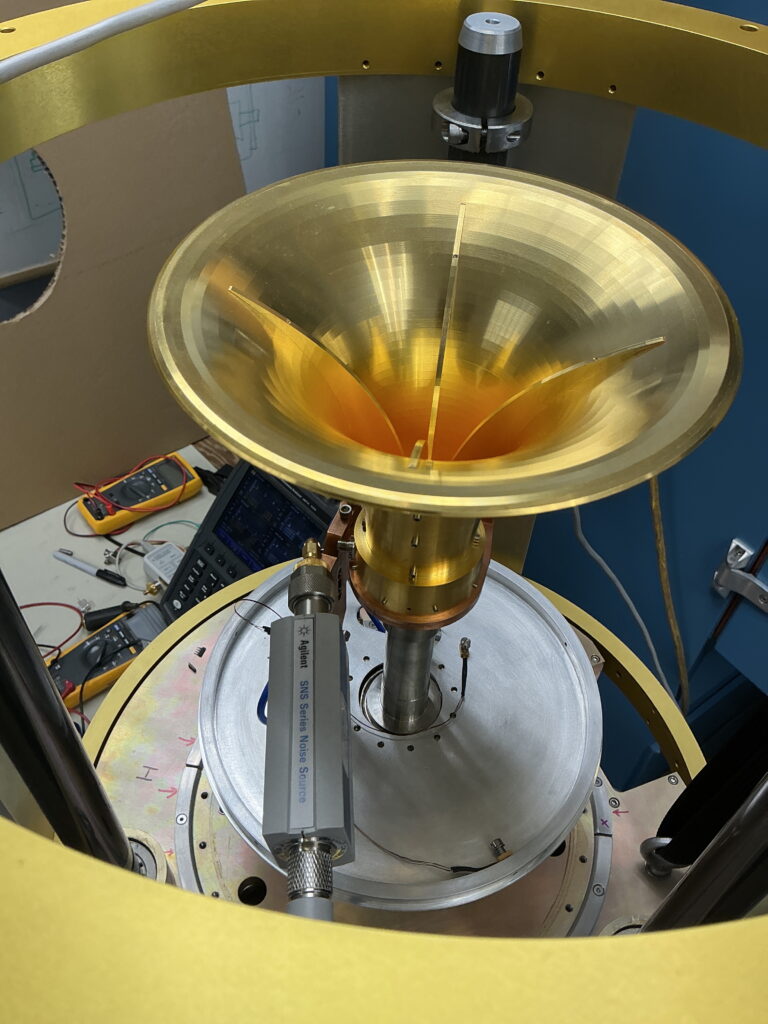
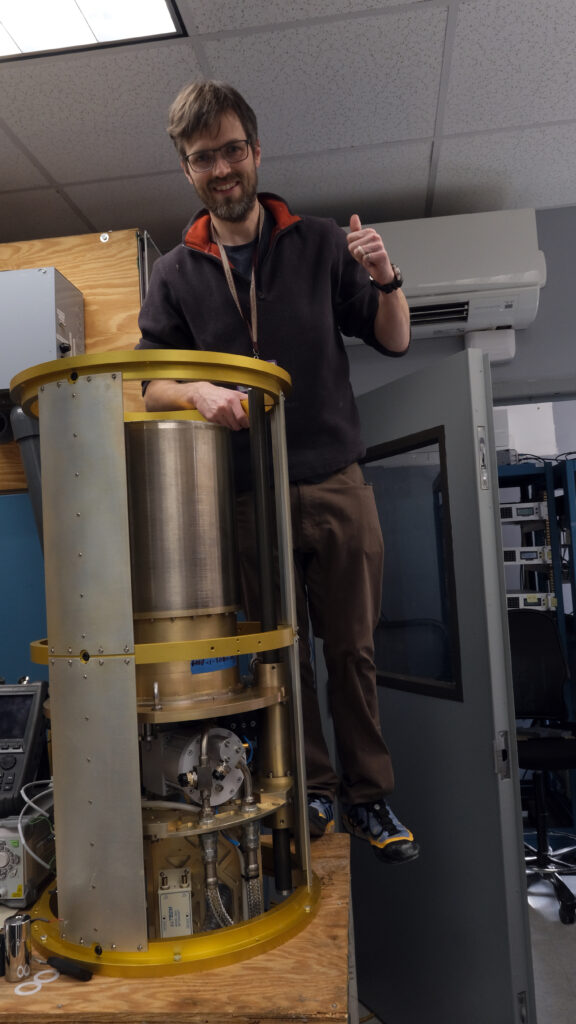
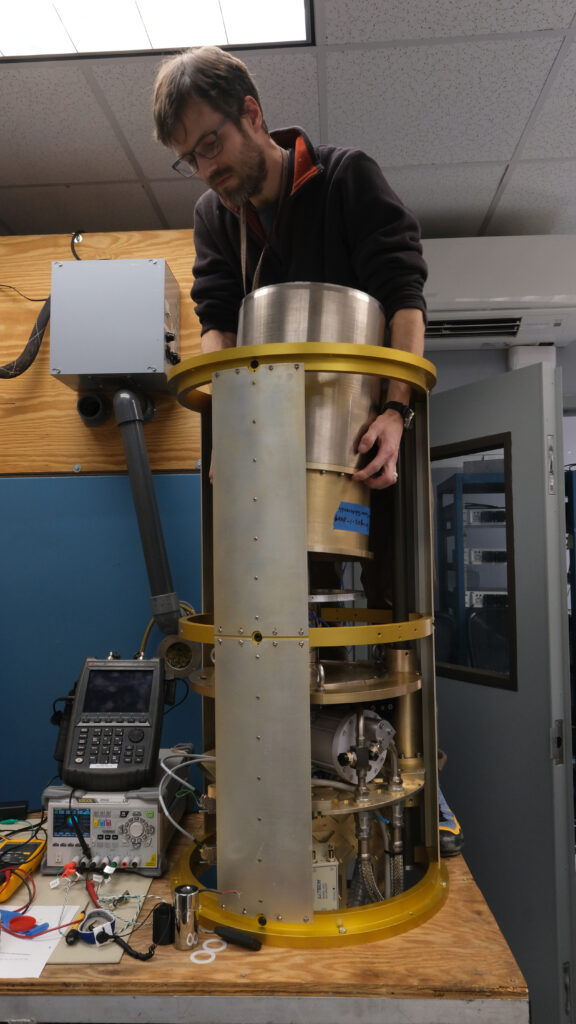
MARCH 12, 2025
The engineering team has been putting the dewar through its paces, and it’s passed all vacuum tests with flying colors. The dewar is the component that encloses the feed and low-noise amplifiers (LNAs) and cools them down to a nice, cold temperature (about 20 kelvin, or –253º Celsius, or –424º Fahrenheit—take your pick), to minimize thermal “noise” and maximize receiver sensitivity. The report says: “lowest residual leak rate ever” in the first, six-hour leak test! You can tell it went well here, because lead engineer Chris Eckert is giving the universal sign of success.
FEBRUARY 25, 2025

Another critical design is in place, thanks to Haystack digital engineer Russ McWhirter. This is the General-Purpose Input/Output (GPIO) board, a component within the digital back end. As mentioned earlier in this blog, McWhirter has finalized the new digital back end (DBEv5), which will be deployed to the Fortaleza antenna and other NASA locations to support the GRITSS VLBI satellites (https://ntrs.nasa.gov/citations/20240002821. In the future, it will be used to support VLBI. The design is particularly efficient, in that the same design will work for either VLBI mode and save costs with minimal customization (in the form of multiple selectable “personalities”) needed.
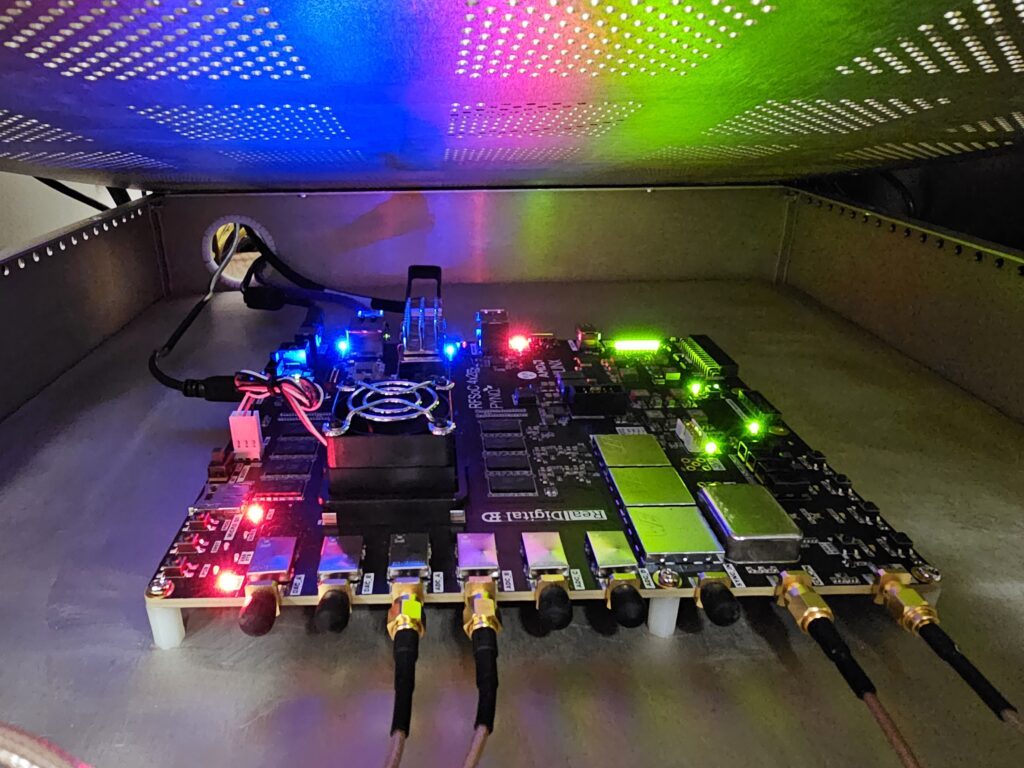
The DBEv5 innards convert the incoming analog signal from what is received by the radio telescope into a digital signal for processing, and then does some of that processing and sends it to the recorders. The GPIO is a key interface board and communications component, which handles several physical status displays (blinking lights, that is) as well as power calibration of the entire signal chain. Even more aesthetically pleasing than the neat GPIO design is its neighbor in the DBEv5: the field-programmable gate array (FPGA), shown here in full holiday colors! More on the FPGA and its very high-speed signal processing, plus the receivers, to follow later.
FEBRUARY 11, 2025
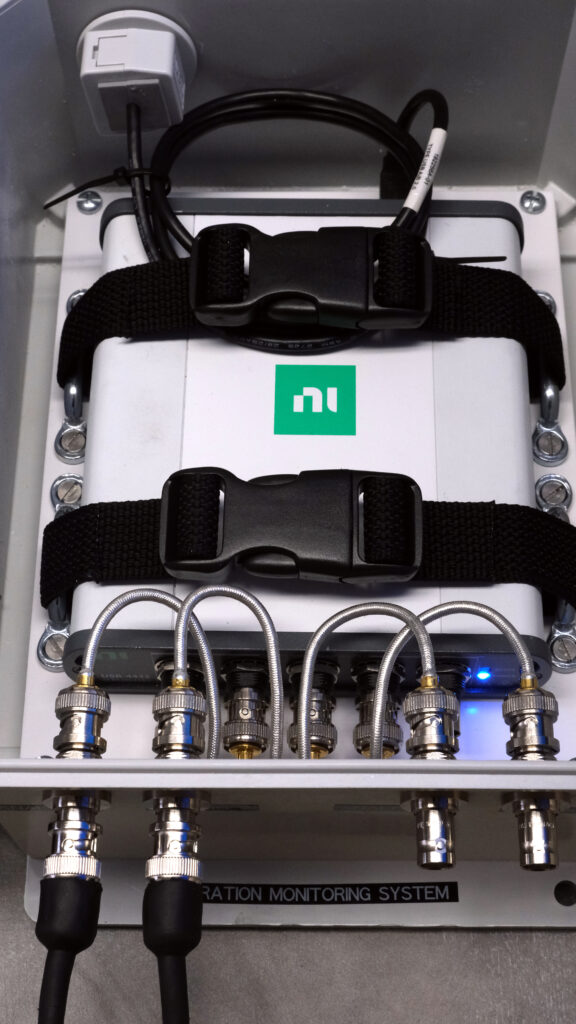
Today’s interesting device is the Fortaleza Vibration Monitoring System (VMS), a tidy little package that does what it says on the tin: monitors vibrations. It’s effectively a way to diagnose the health of the radio telescope, with an accelerometer on the sides and back of the dish. Haystack developed this subsystem, used in combination with but separate from the front end components. By measuring vibrations at different frequencies, this machinery will allow operators to remotely monitor and assess several aspects of the radio telescope’s state, including balance, misalignment, and mechanical rigidity.
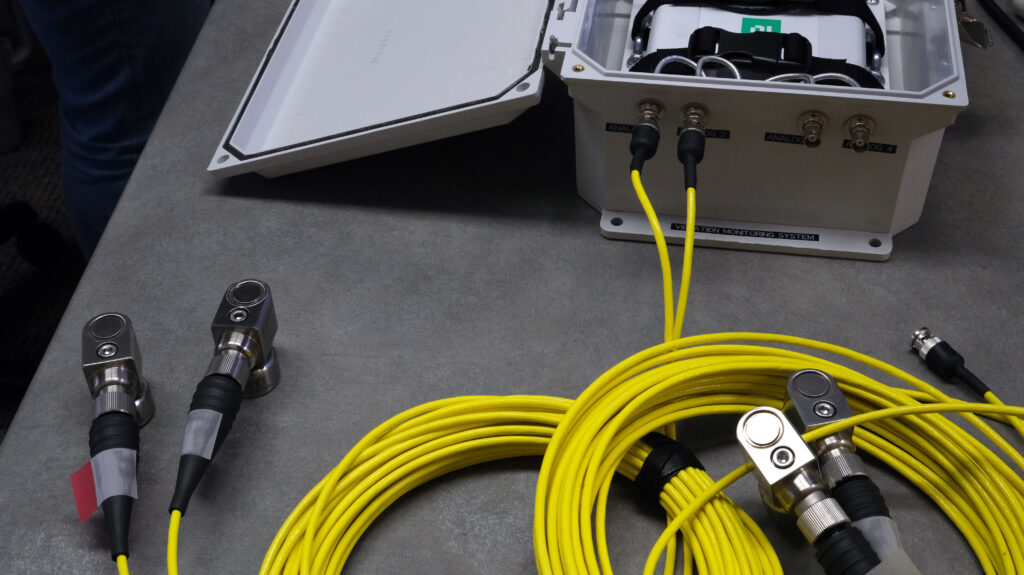
Shown here is the VMS, with its accelerometers, plus the LabVIEW accompanying software. This component is in the final assembly and testing iterations, in the capable hands of Haystack’s Christine Alcalde. In the images, you can see an informal test of the device—her cell phone was vibrating at 150 Hz!
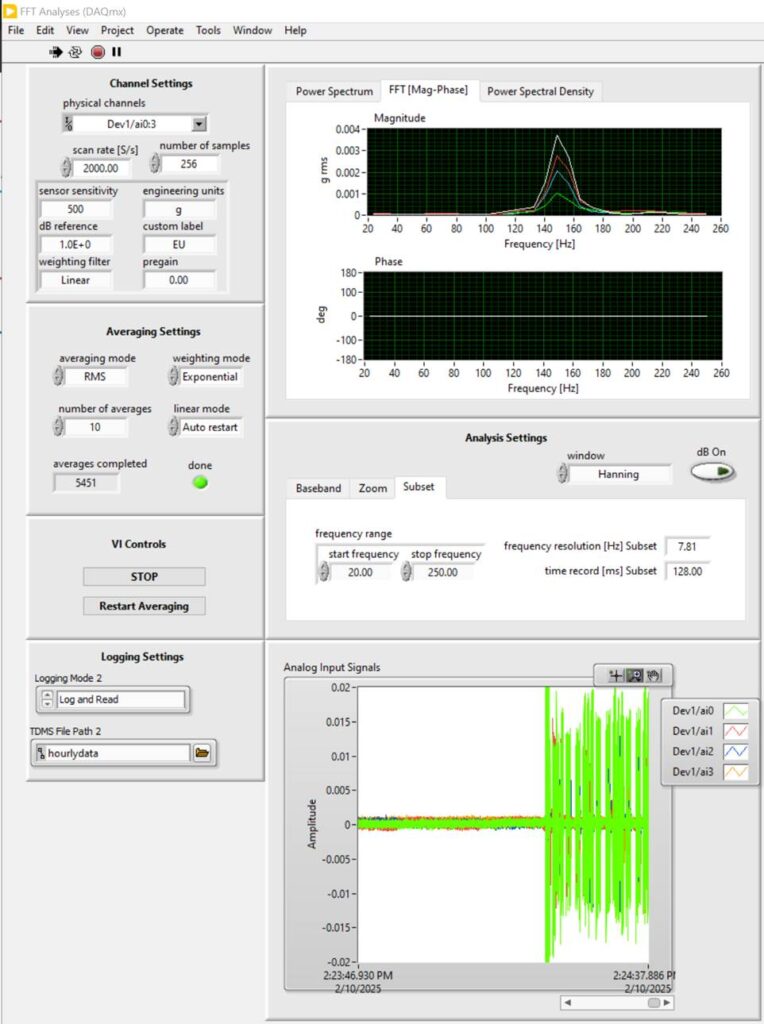
FEBRUARY 5, 2025
Things are heating up in the Haystack engineering laboratories! As we are approaching some major milestones and deadlines, we will try to update this blog more often so that you can see what cool stuff is going on.
A current focus (among other things) is the hub enclosure, a complicated component consisting of a box for routing and managing incoming power to the entire front end. The hub enclosure has been redesigned for this antenna build, with improvements that prioritize the management of a stable, clean power source to the various components of the Fortaleza radio telescope.
Here’s an image of the newly updated hub enclosure design, held (and created) by Haystack engineer Chris Eckert. Chris has rearchitected the entire hub enclosure in exquisite detail, as shown here, with fewer power supply components and a better handling of power through local regulation within the hub enclosure itself, in conjunction with the DC breakout board (see previous entry). Onward and upward!
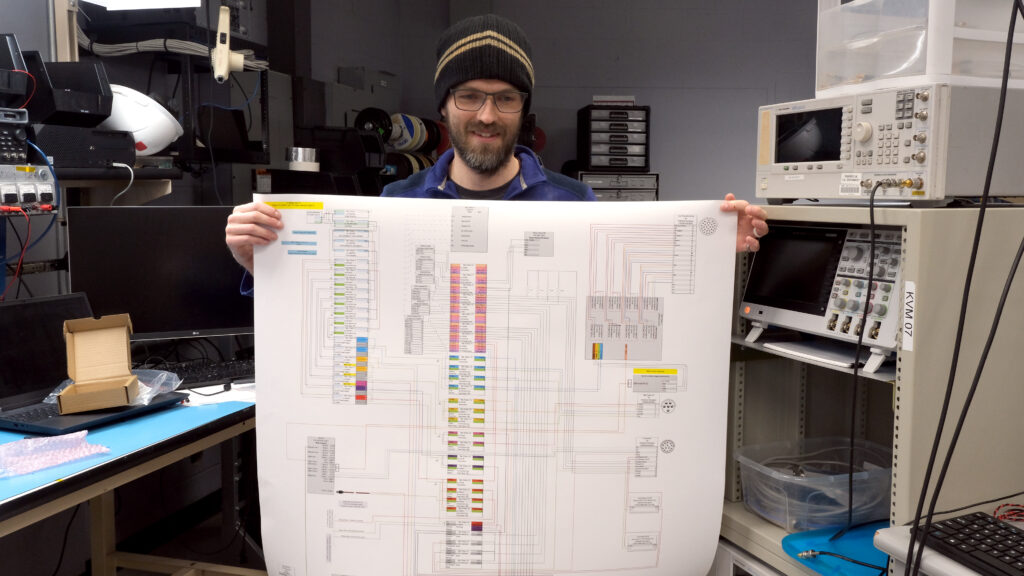
JANUARY 22, 2025
HAPPY NEW YEAR! Welcome to 2025 and the ongoing build process of the Fortaleza signal chain.
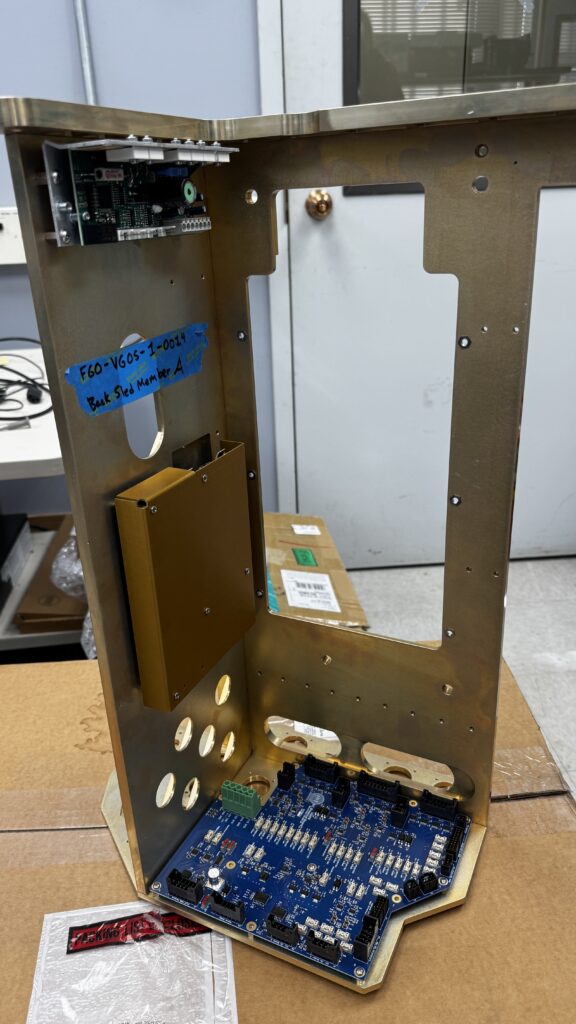
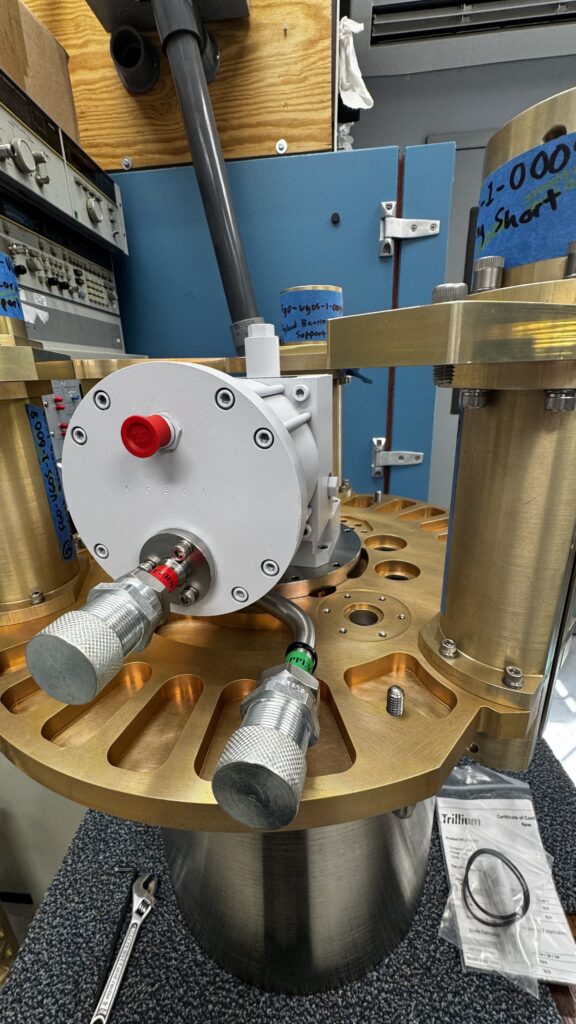
Things are visibly ramping up in the Haystack lab, where many of the signal chain components have arrived and a big unboxing party is taking place. Some examples are shown here! These items include the front end back sled, which contains the VGOS DC breakout board, engineering here at Haystack, which monitors and safely distributes the incoming power to all payload components. The front end payload is the bulk of the signal chain, which slides into the positioner and can be retracted for maintenance and upgrades after installation.
Also shown is the main frame of the payload, including the white helium refrigerator, which cools the feed to necessary cryogenic temperatures to minimize thermal noise as a source of signal interference. This forms the base of the dewar cooling component and is where the feed is mounted inside the dewar. It’s all coming together!
More hardware images and descriptions on the way soon, as well as some receiver updates. It is a busy season for this build, so stay tuned for the latest.
DECEMBER 17, 2024

What’s happening in the lab today? Enough for numerous blog posts (stay tuned!), but today we’ll look at the Vibration Monitoring System, a device that measures movement of the radio telescope dish. As you can see on the screen here, it displays finely detailed movement tracking, and also detects any resonances (vibrations resulting in other vibrations) that arise when the dish moves.
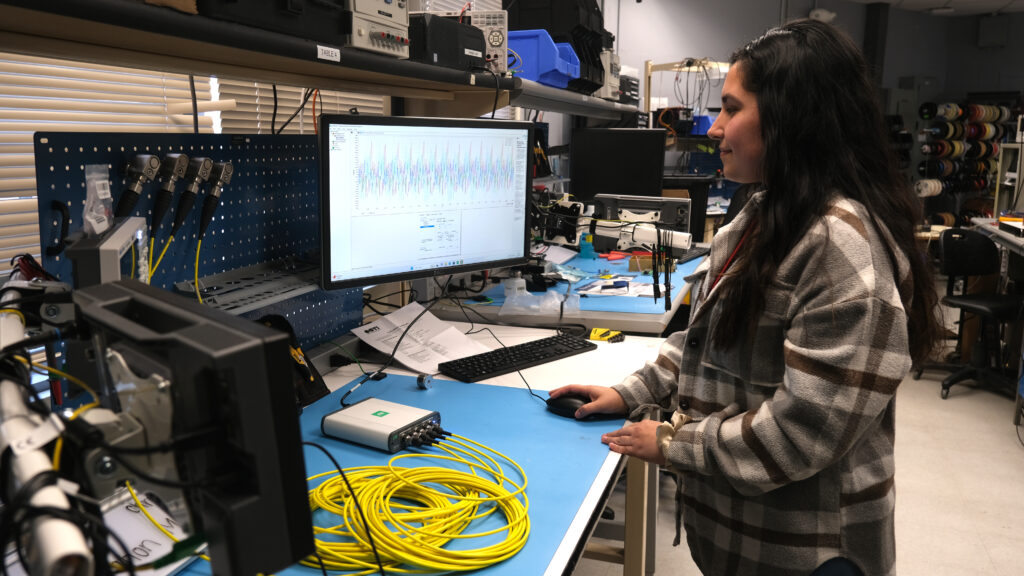
The sensor is one of the many projects that Haystack’s Christine Alcade is working on, usually quietly, behind the scenes, until today—straight to the front page! She will build four of these sophisticated devices to be placed at various locations on each of NASA’s radio telescope, including Fortaleza, so that observations there will be stable and accurate.
Happy holidays to all from the Haystack geodesy science and engineering teams!
NOVEMBER 13, 2024
WELCOME to the most recent addition to the Haystack geodesy laboratory team: Abiel Mendez!
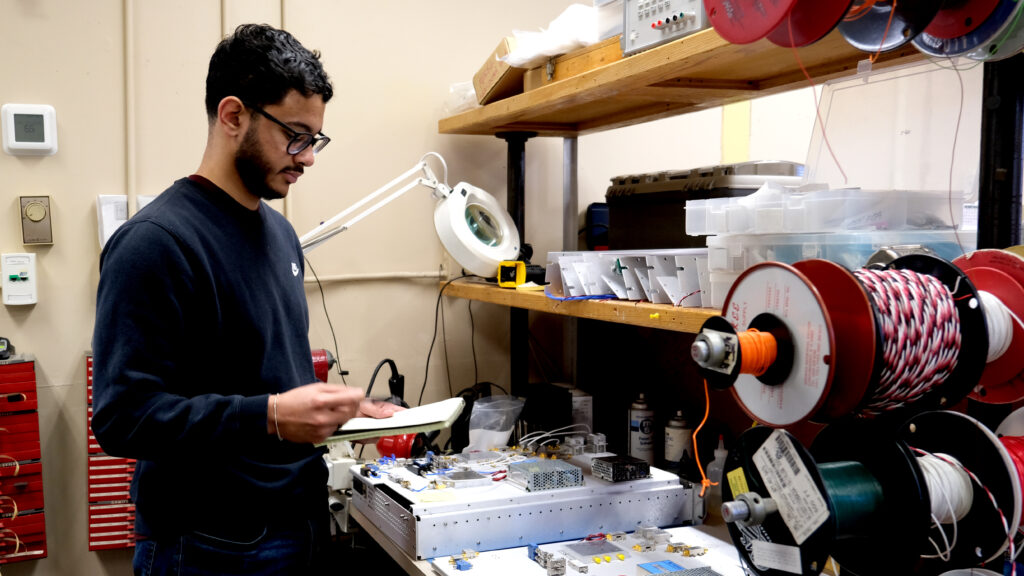
Stationed at the Westford Radio Telescope at Haystack Observatory, Abiel is a skilled technician contributing to signal chain construction for NASA VGOS telescopes. His current focus is the up-down converter (UDC, to its friends), a radio telescope signal chain component that “conditions” the signal to get it ready for the R2DBE (the digital backend). This means that it up-converts the incoming signals to a common frequency, then down-converts that signal to a frequency that the R2DBE can process for digitization. The Fortaleza-bound UDCs are in great shape—thanks to the Westford team!
OCTOBER 3, 2024
The components of the CDMS (Cable Delay Measurement System) are designed to be high-functioning and efficient; it’s too bad that they’re behind the scenes, because the plated aluminum parts that arrived recently look great. They’re surprisingly light when you pick them up.
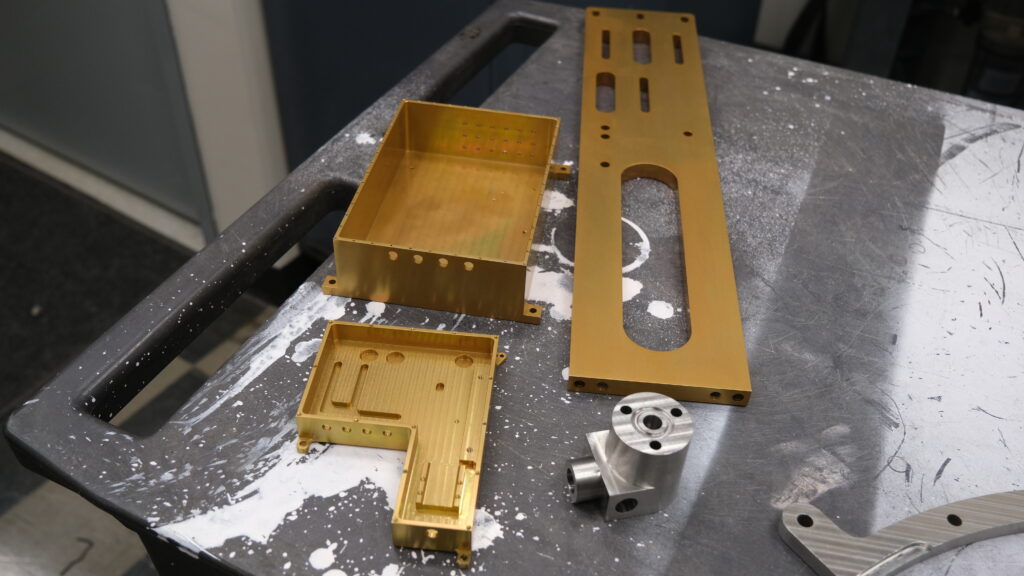
The CDMS, developed by MIT Haystack Observatory, aids in determining instrumental delays in VGOS antenna systems, including Fortaleza. The system calibrates for cable delays, signal phase, and signal amplitude by incorporating an active picosecond cable delay measurement capability, injecting a 5 MHz calibration and a switched noise signal for post-processing corrections. And looks good doing it. The components haven’t been officially unpacked yet; after this stage, they’re off for assembly!
AUGUST 21, 2024
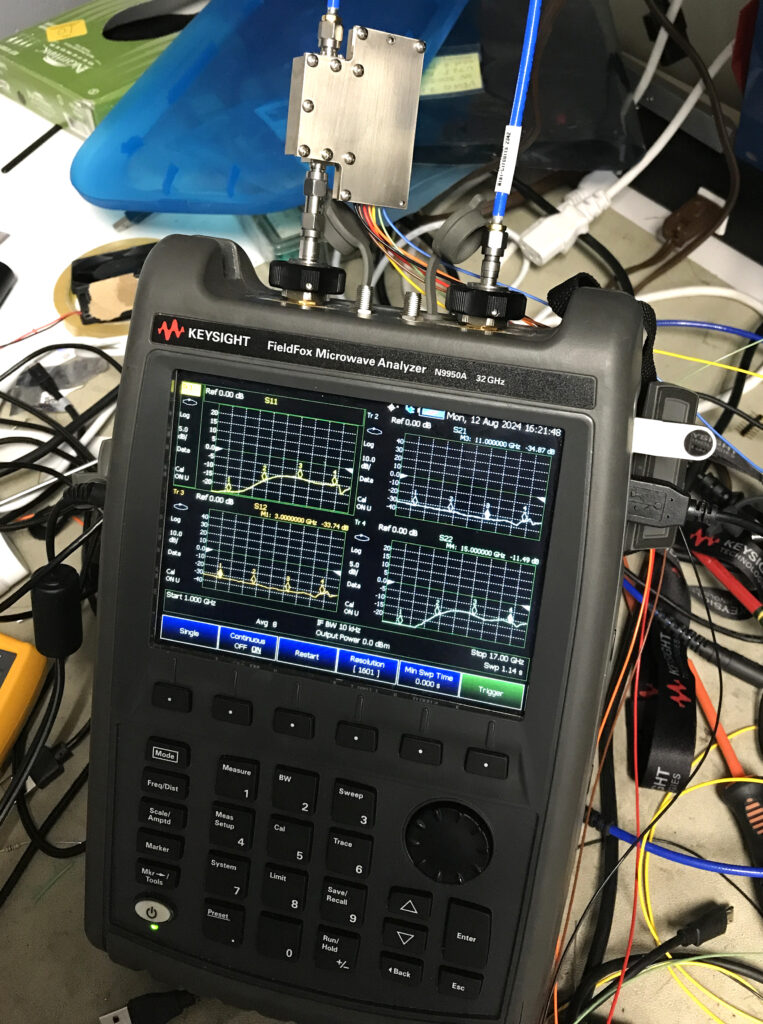
Shown here is the test setup for one of the new attenuators for the FGO antenna. An attenuator does what it says on the tin: it attenuates—or reduces—the gain, or strength of the signal, within the signal chain. Those of you who are not radio telescope engineers might wonder why one would want to reduce the strength of a signal: why wouldn’t you want the full signal at peak strength? Turns out that you need to equalize the signal across a wide frequency range (2 to 14 GHz or 2000 to 14000 MHz), and that it is divided into different channels later in the signal chain.
When splitting a signal across channels, such as when they get to the digital back end (DBE), it’s important to be able to control or attenuate the signal so that each part is the exact same strength across different channels. Attenuators also help in reducing the impact of radio frequency interference (RFI) from emitters like cell phone towers, wireless routers, and satellites.
JULY 19, 2024
Things are really coming together now! Here two of our technicians, Tony and James, are working on the Fortaleza antenna’s positioner, which does what it sounds like (positions the antenna feed). Much more to come, including additional positioner progress and a look at the new breakout boards!
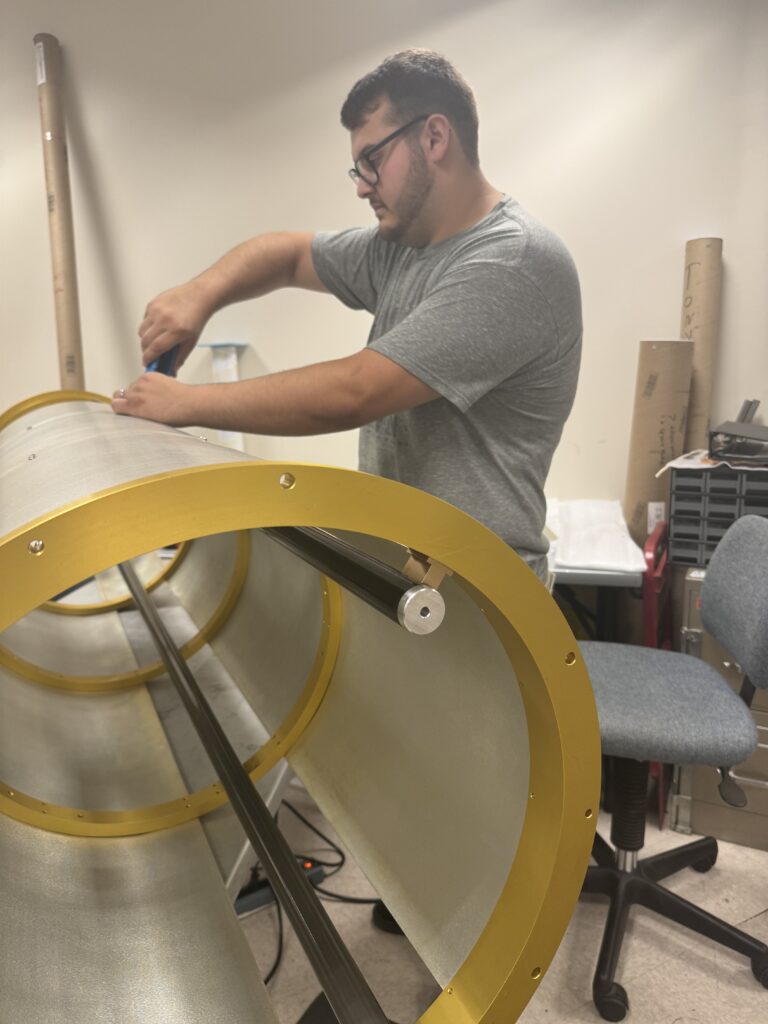
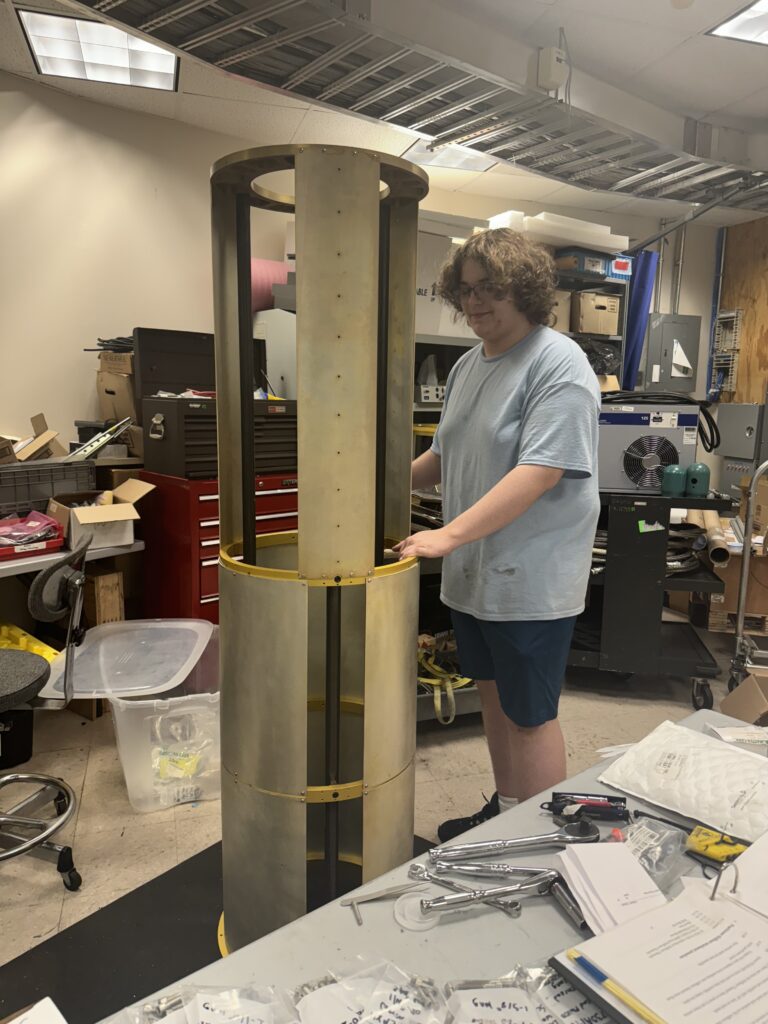
JUNE 11, 2024
In today’s electronics lab update, the VGOS amp regulators are being assembled and stress-tested. The distinctively purple Haystack boards regulate the power flow into the RF amplifier on the front end of the antenna. This part of the signal chain requires a very clean incoming DC power source, meaning that the voltage must be sent in at a predictable, specified rate only. The extra voltage that is discarded is converted to heat, so our engineers test them—as shown in the heat map images here. Updated to add: AND THEY PASSED WITH FLYING COLORS.
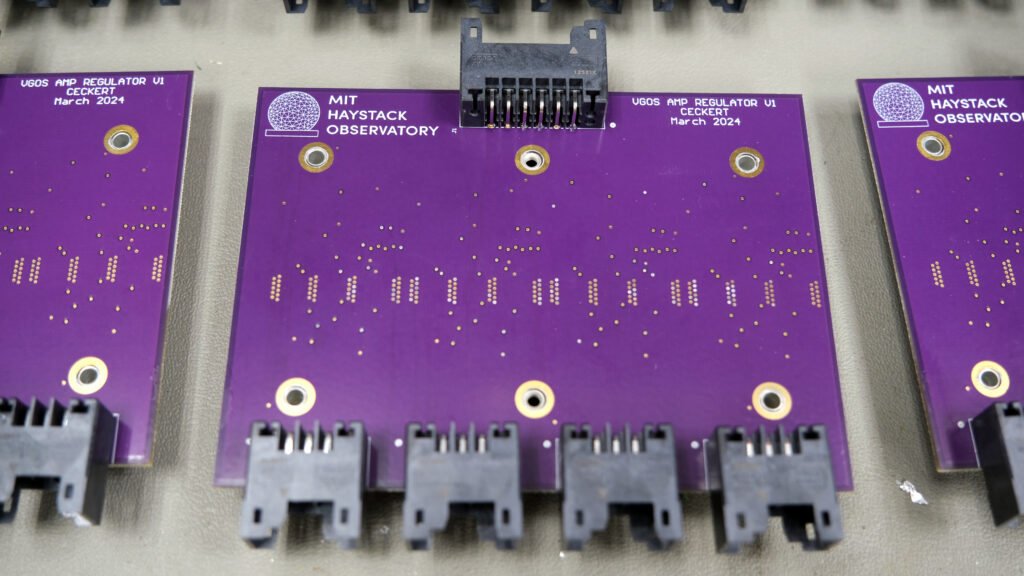
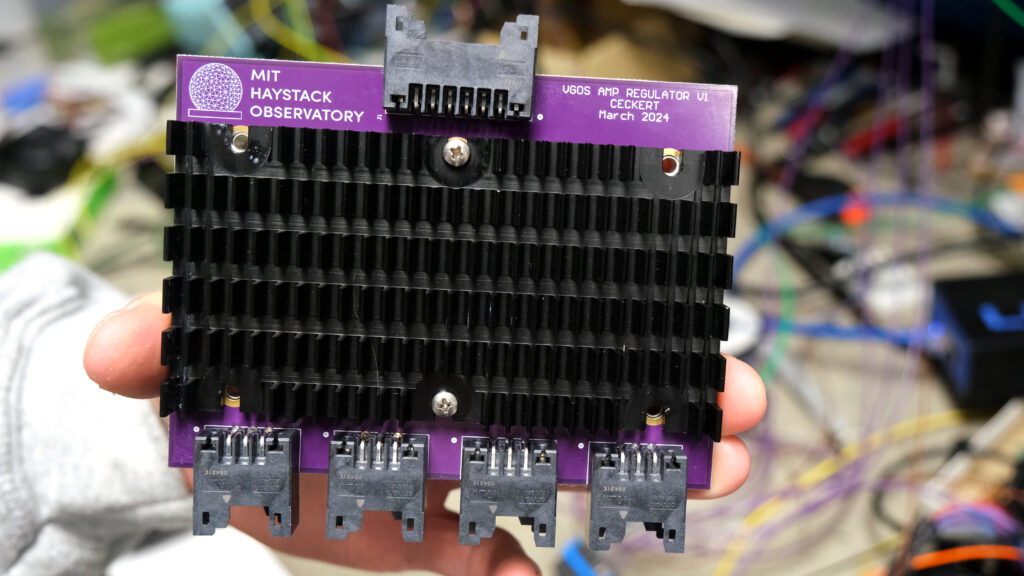
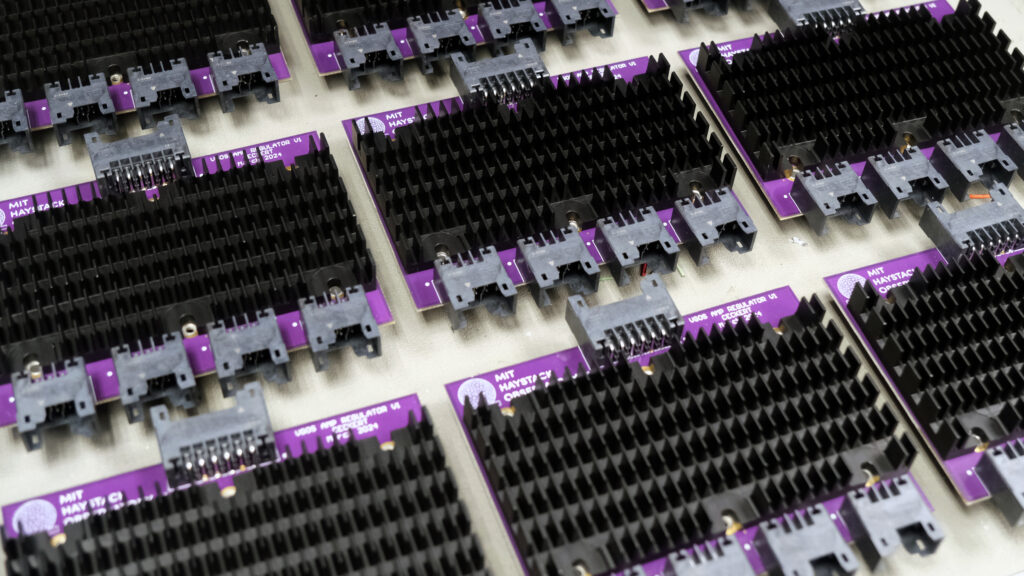
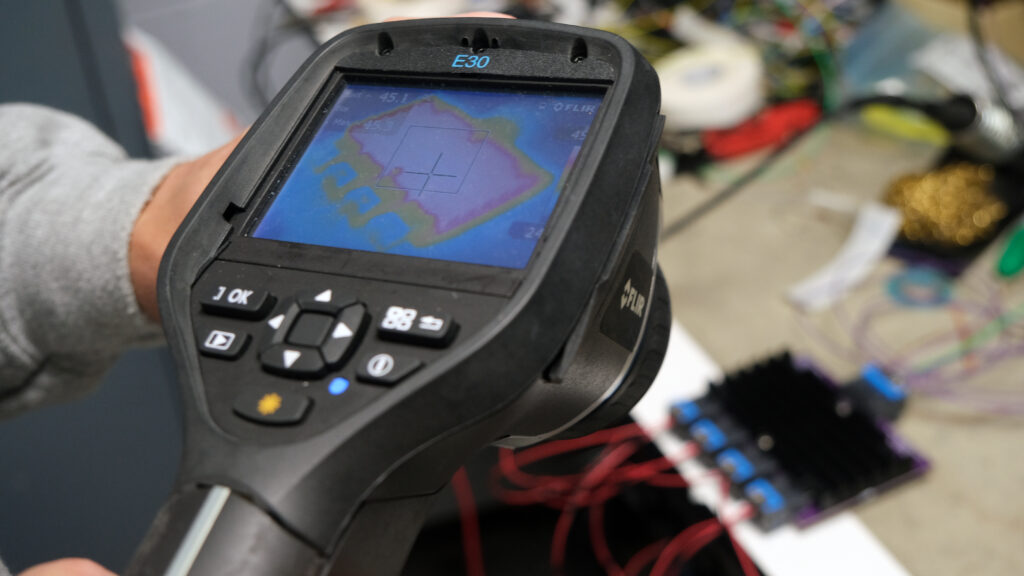
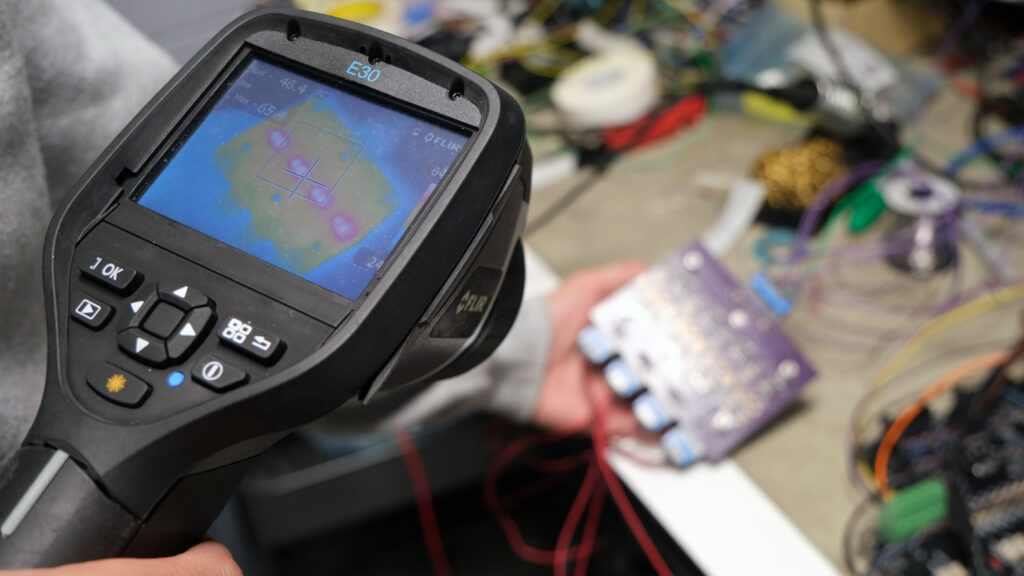
MAY 29, 2024
The Haystack Open House events resumed this month, with overwhelming interest, and the geodesy team was well represented to answer the many questions from the general public, all the way from “what is geodesy?” to detailed technical inquiries about our projects, including the Fortaleza build. Welcome to the people who got this link from the Open House! We greatly enjoyed meeting our neighbors and talking about our science and engineering research, as well as promoting STEM career paths for the kids who came to Haystack.
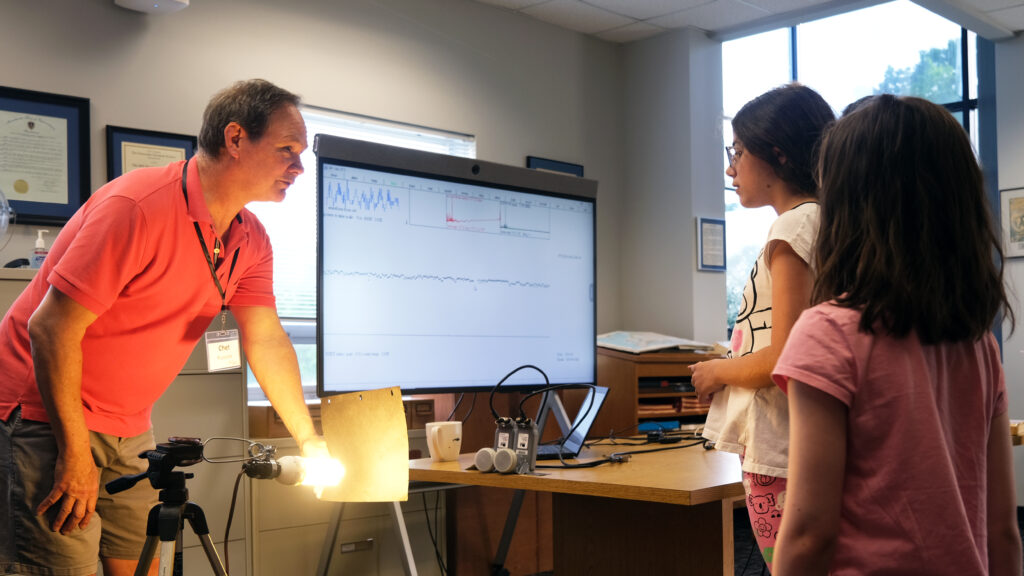
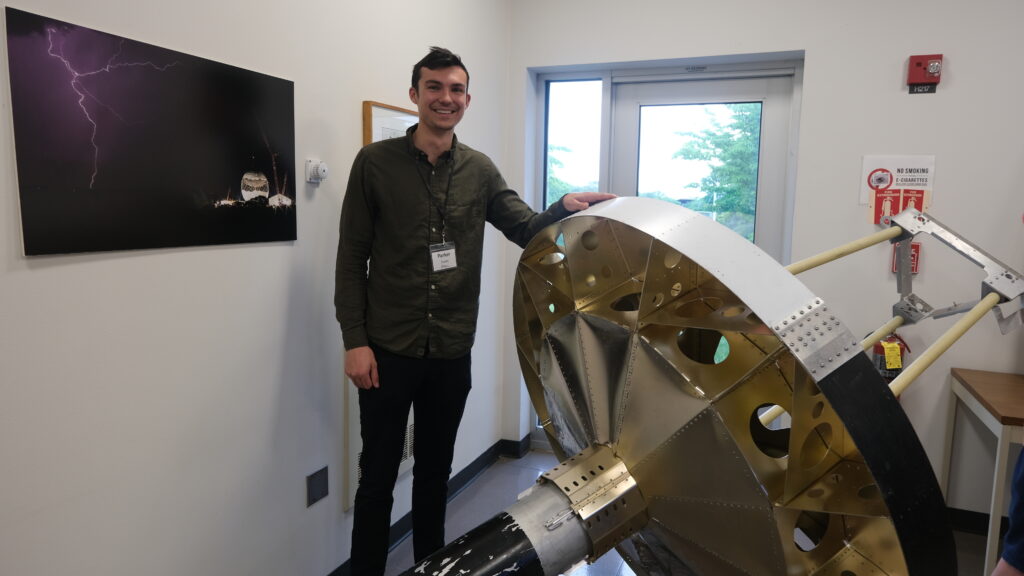
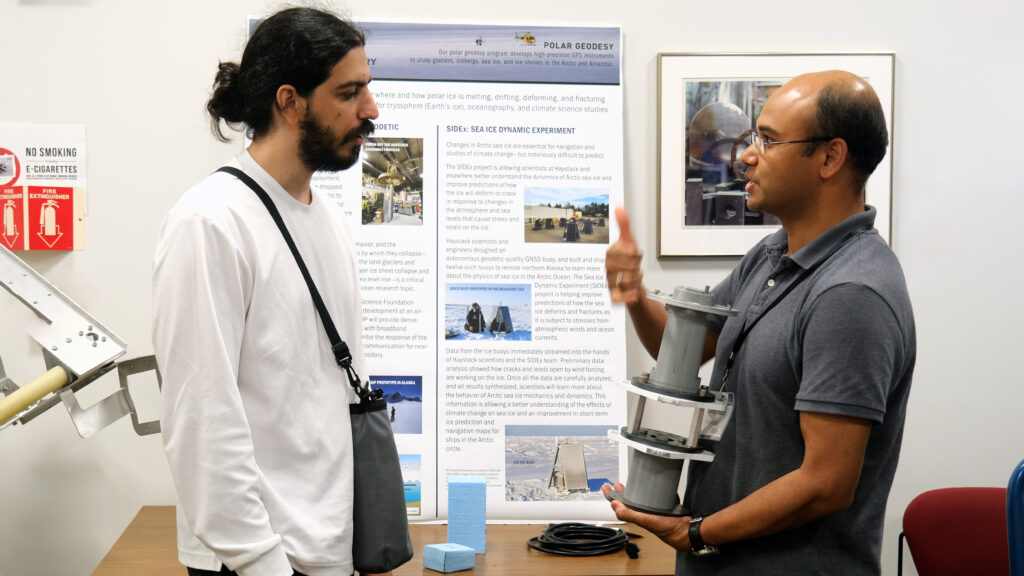
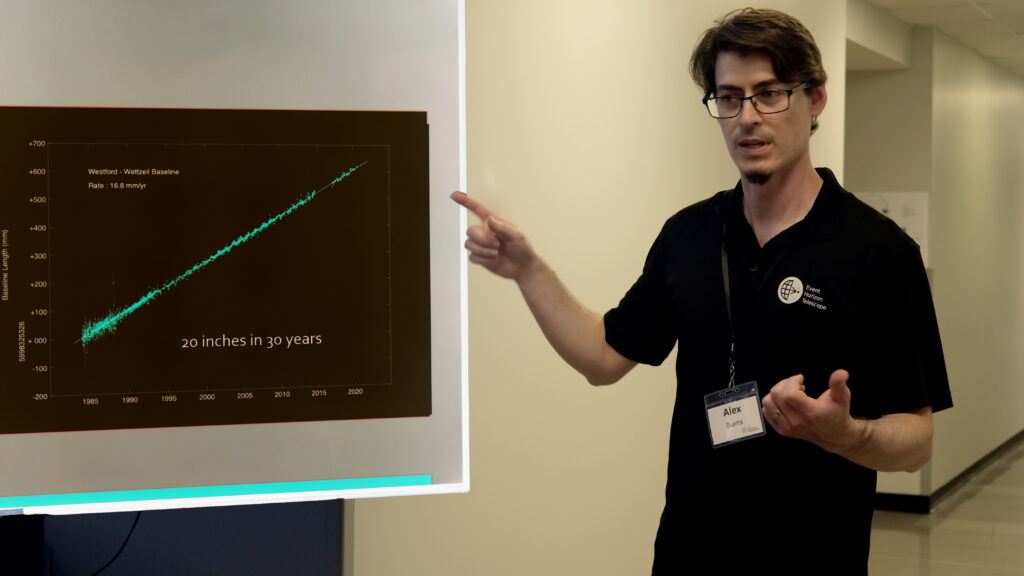
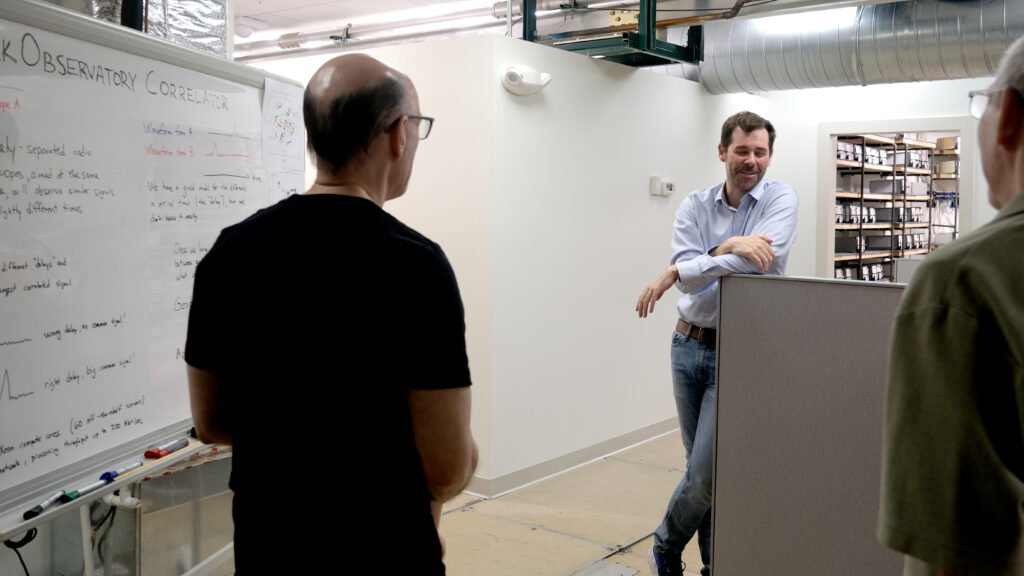
MAY 15, 2024
SUPER-COOL: Some sparkly, newly plated hardware is in the shop: the machined parts for the telescope’s dewar. The dewar is the component that keeps the amplifiers in the antenna feed good and cold (about 20 degrees Kelvin, which is –253º Celsius, or –424º Fahrenheit, depending how you like your freezing cold), to minimize thermal “noise” in the receiver that would negatively affect the data quality. (Cold means better sensitivity, or detecting fainter objects faster, so is good.) The pieces are much lighter than they appear at first glance; they are machined of aluminum and then plated, as shown.
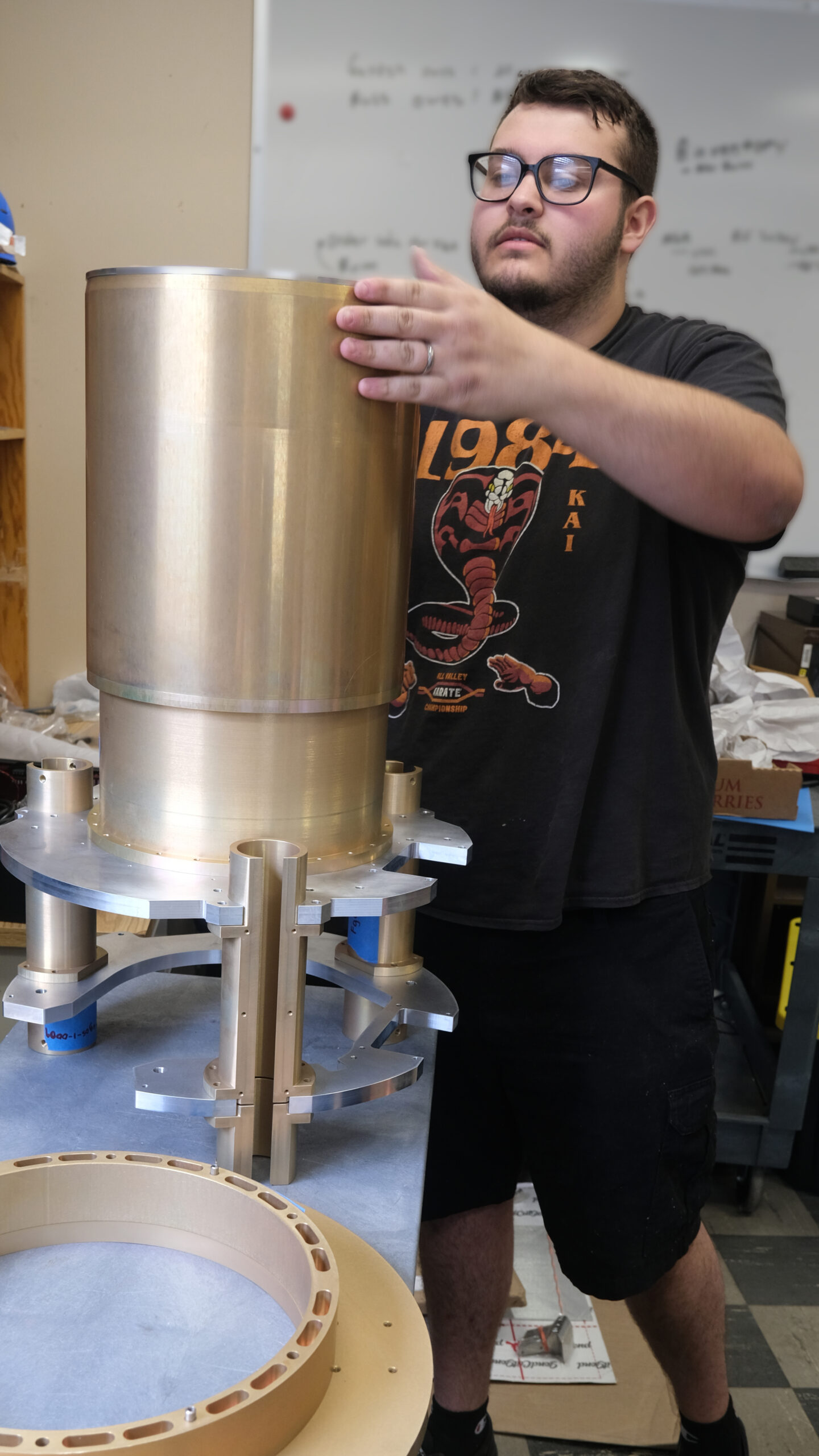
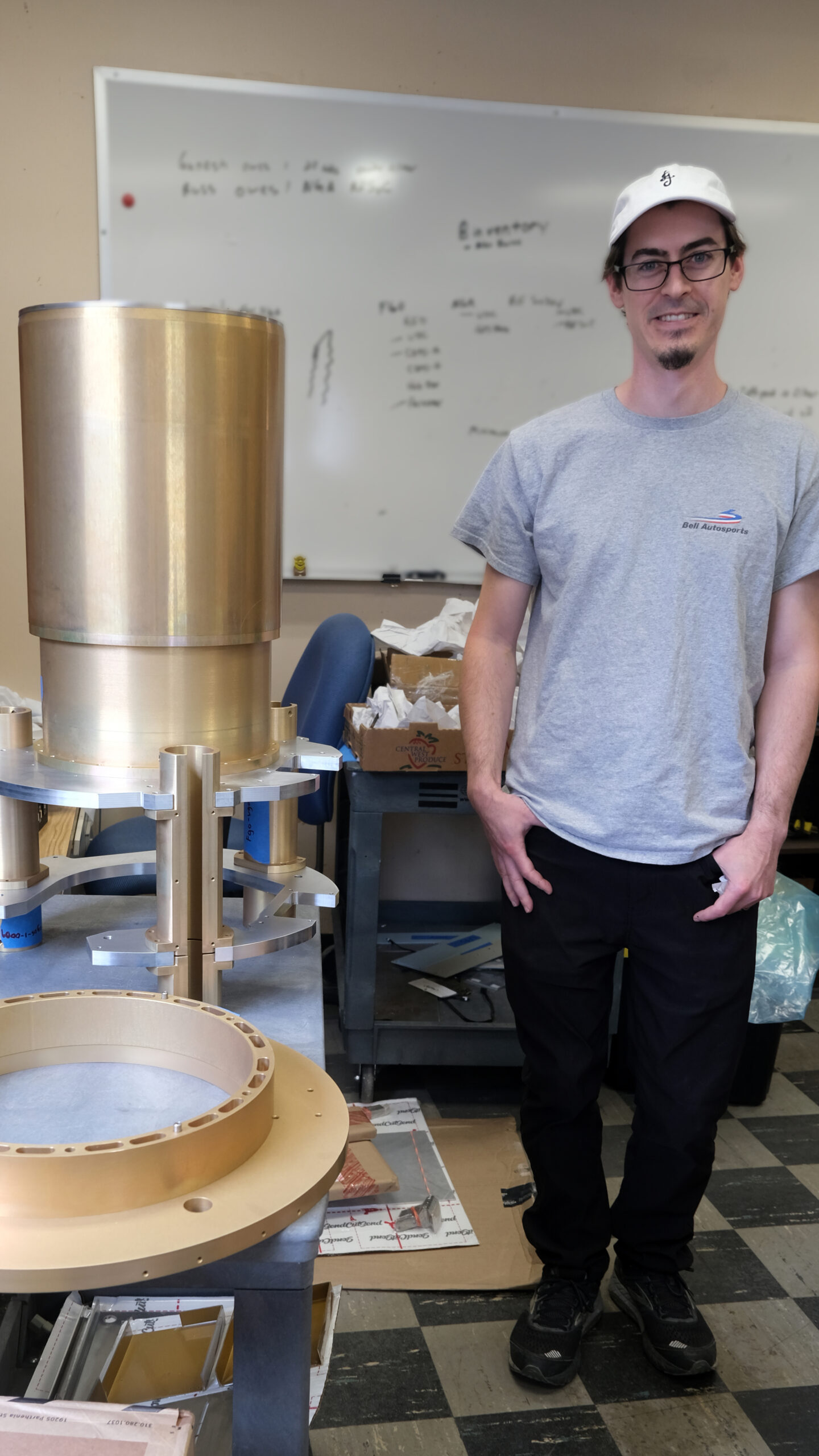
APRIL 25, 2024
If you’ve been following along, you might have thought the VDAQs (VLBI Data Acquisition boards) had arrived back in November. But you would be wrong! Those were the early prototypes, and were used to validate our innovative new design, which includes a state-of-the-art microcontroller on the main circuit board along with the VDAQ.
Today, the first production-run units have entered the building. Their software (bootloader, firmware, etc.) has been loaded and the hardware is in testing (so far, so good).
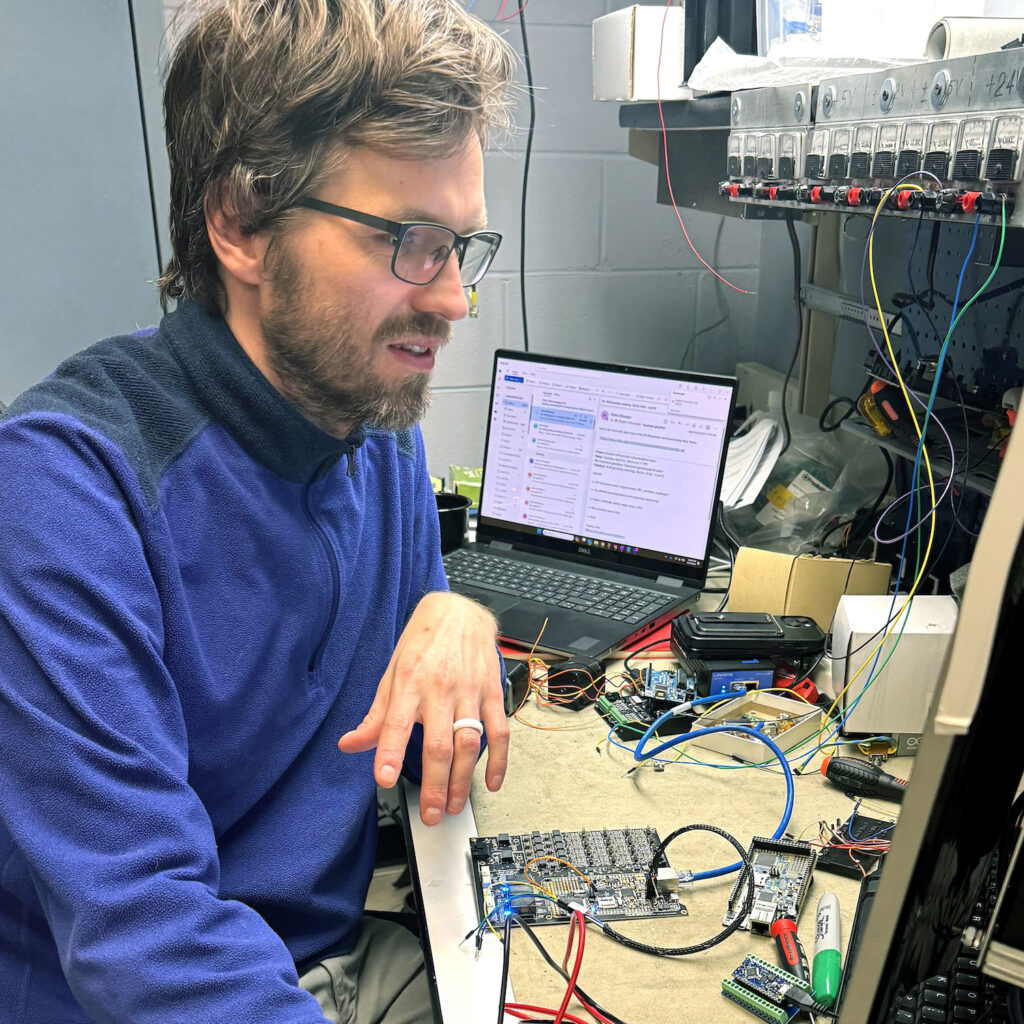
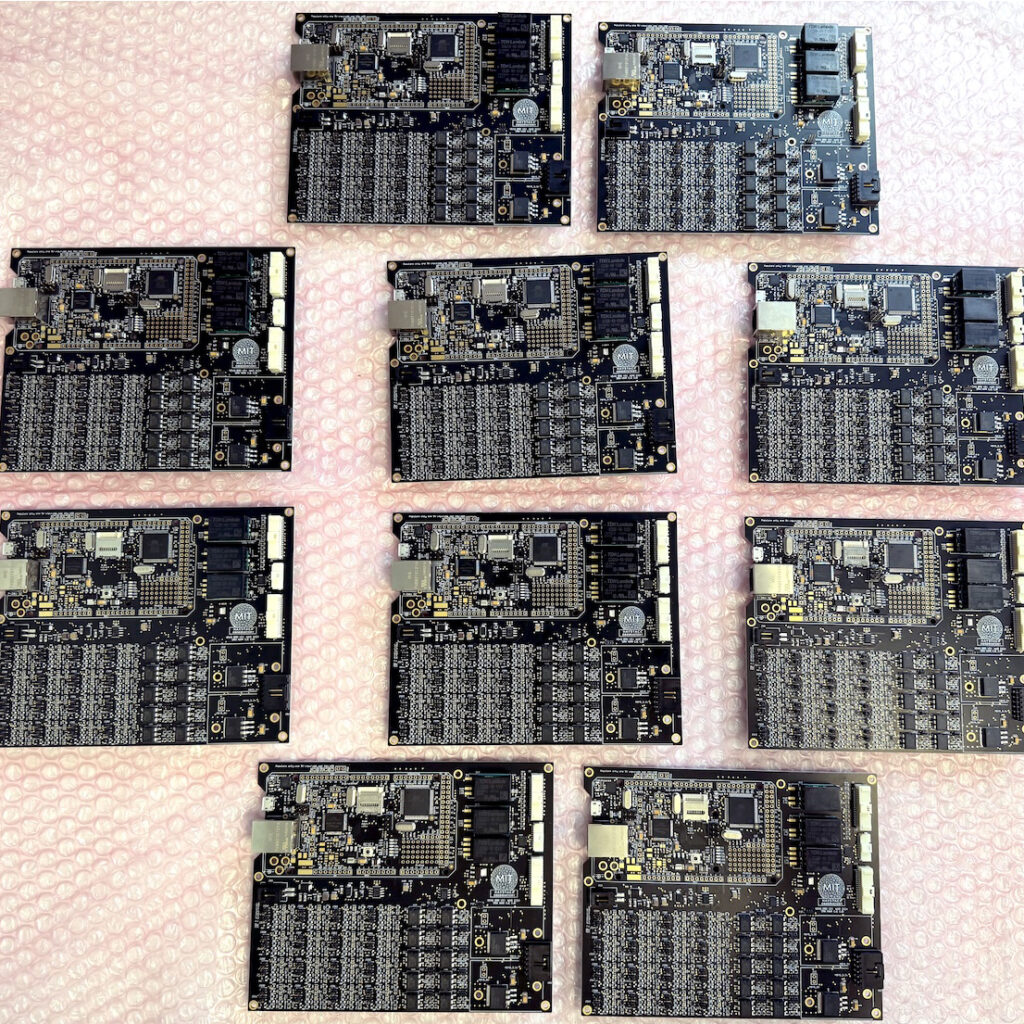
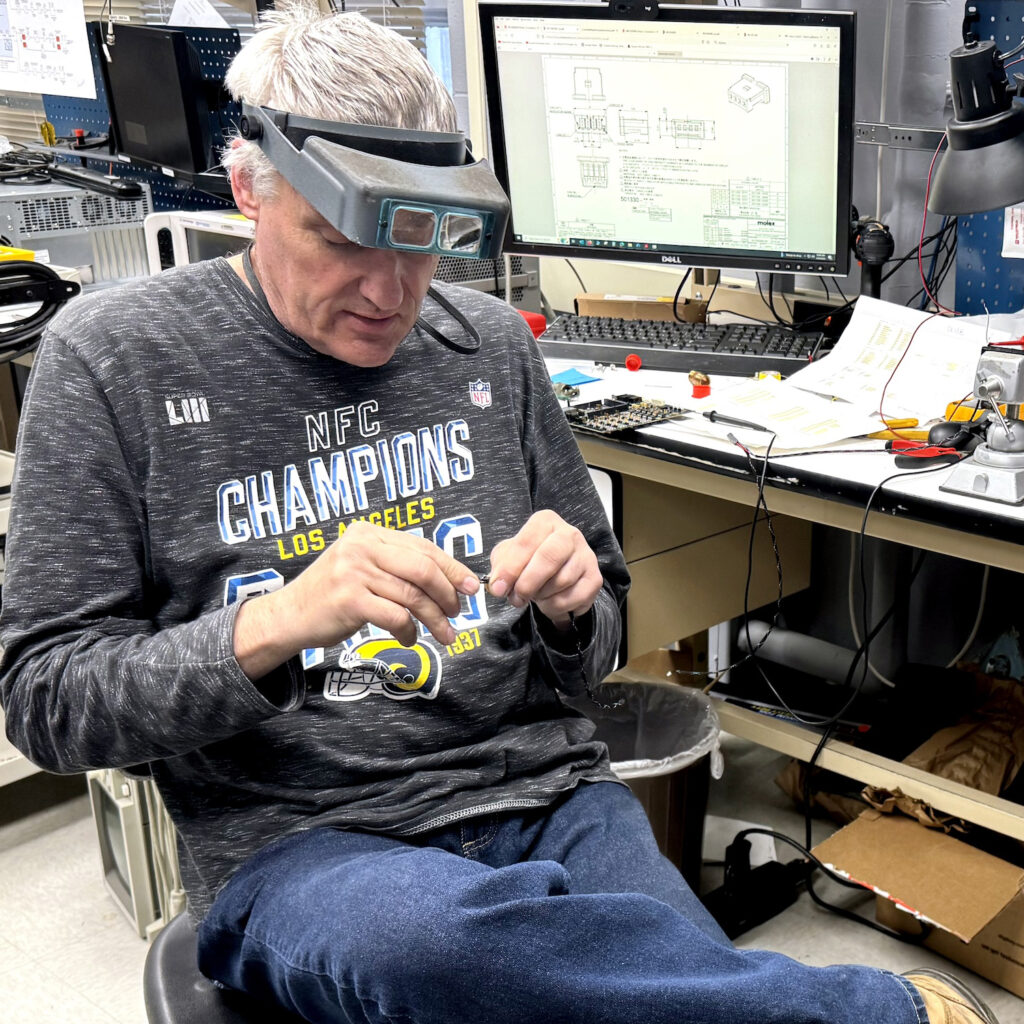
MARCH 20, 2024
We have some preview images available of shiny new parts! These custom-designed metal components (along with many additional ones) have just been machined by the engineering team, all part of the “payload” (where the signal is received in the antenna’s front end) support structure.
The leftmost plate in this figure is the base plate for the dewar. The dewar is basically a double-wall vacuum bottle, akin to a drinking mug that keeps your drink cold—but here “cold” means cryogenic, or down to about 20 degrees Kelvin. That’s way too cold for your iced coffee, but antenna feeds love it!
Next on the plan for these parts is inventory, inspection, and then they’re off to be plated—more to come shortly on their journey to Fortaleza.
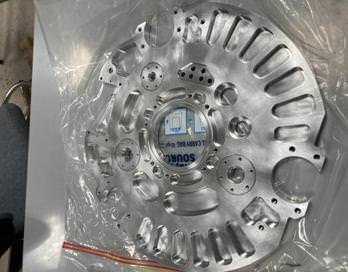
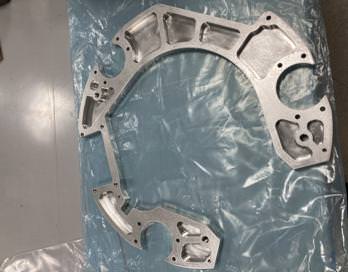
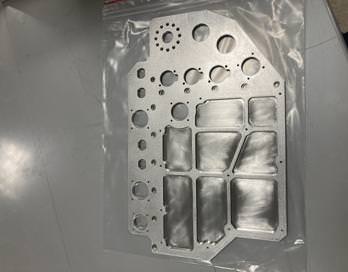
FEBRUARY 13, 2024
This week’s milestone: successful Preliminary Design Review (PDR) for the VGOS Digital Backend (DBE) version 5, by Haystack’s Russ McWhirter. The digital backend digitizes the signal, which means converting the analog received signal into a digital one (amongst other processing steps).

The new design, version 5, has many upgrades—and amazingly, manages to provide these improvements at a significantly lower cost! The networking output will be increased to 100GB, from 10GB previously. The digitized signal will be output at 14 bits instead of 8 previously, meaning better performance abilities for locations with radio frequency interference issues (an increasingly common problem). The DBE upgrade will also add a completely new feature: the capability to receive a signal from a new small NASA satellite, GRITSS. Because our engineer has designed this board with integration of previous hardware directly into the new chip, it is also much more affordable to build than the old version—major improvements.
All of this is on schedule for delivery at the end of 2024, so although it is not in time for the initial Fortaleza signal chain, it will likely end up at FGO at a later date. Russ has an exciting 2024 ahead of him.
FEBRUARY 13, 2024—MILESTONE: VGOS DIGITAL BACKEND v5 PDR (PRELIMINARY DESIGN REVIEW)
FEBRUARY 7, 2024
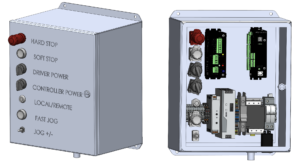
Another milestone last month: a successful Critical Design Review (CDR) on the power and control system of the payload positioner for the Fortaleza antenna. This component moves the antenna’s feed into position and retracts it after an observation. At the CDR, the preliminary design was documented and reviewed, with the main presentation given by Haystack engineer Christine Alcalde. The payload positioner controller, designed by Alcalde and Parker Steen, is a single-axis step motor controller with built-in controls designed to provide flexibility and independent control of the position of the payload. The system is built to be robust and dependable, and designed to function effectively in harsh industrial environments. In the Haystack design, we implemented safety features to ensure complete protection of personnel and equipment, such as emergency stops and fault detection.
JANUARY 19, 2024—MILESTONE: POSITIONER CDR (CRITICAL DESIGN REVIEW)
JANUARY 10, 2024
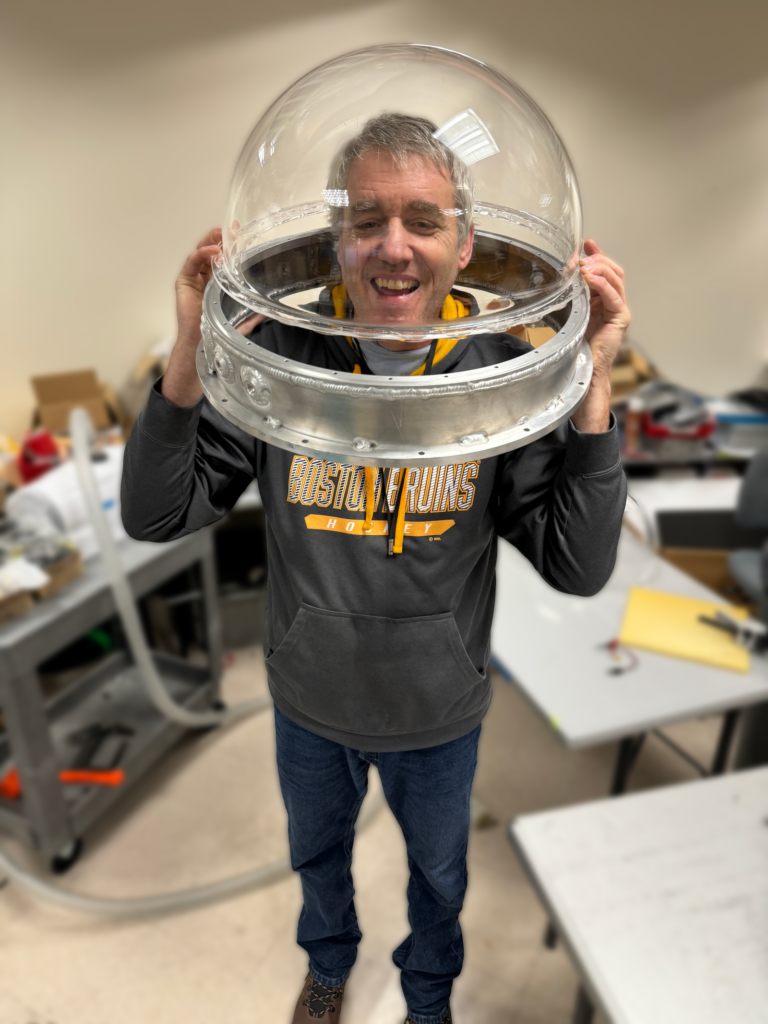
Happy New Year 2024 from everyone at MIT Haystack Observatory working on the NASA Fortaleza antenna build project! We are looking forward to many updates this year, with a challenging schedule and lots of milestones just ahead.
The plexiglass radomes are morphing into their final form, bit by bit—we have found them to be useful in multiple situations, besides protecting the NASA antenna feeds. The metal flanges, shown here, will attach the mini radomes to the feed tube portion of the antenna.
DECEMBER 13, 2023
Parts and equipment have been arriving—just in time for the winter gift-giving holidays. One of them, seen here, is a small “radome” made of plexiglass. These bubbles cover the antenna’s feed and help protect it from various environmental conditions. Other NASA antennas will also be upgraded to include these latest mini-radomes. Onward and upward: assembly starts this week!

NOVEMBER 3, 2023
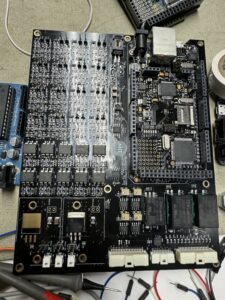
The VDAQs have arrived! At Haystack, VDAQ stands for VLBI Data Acquisition (VDAQ) board. These boards, designed at Haystack and custom-built for the Fortaleza antenna signal chain, let us remotely examine and monitor the condition of hardware, and control parts of the signal chain. They allow engineers to diagnose issues and are a major component of multiple antenna systems. There will be a total of 8 VDAQs in this antenna.
Right now they are in the lab (see figure), being tested to make sure they function properly and match the design schematics. Keep your fingers crossed that they all pass the rigorous testing procedures!
And make sure to note the elegant Haystack logo, prominently featured mid-board.
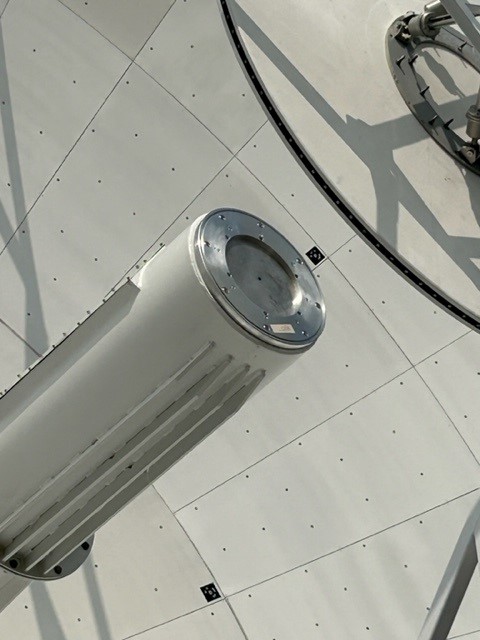
OCTOBER 2, 2023
Good news, everyone! The FAT (that’s Factory Acceptance Test) went well, and the interface plate and its new VGOS antenna passed with no major issues. Congratulations to all teams working on this complicated project.
SEPTEMBER 28, 2023—MILESTONE: FAT (FACTORY ACCEPTANCE TEST)
SEPTEMBER 27, 2023
Remember this thing? It’s the feed interface plate that will join the ISI-built antenna and the Haystack-built feed. The plate is now winging its way north [UPDATE: it has arrived! see image], courtesy of our shipping manager Don Sousa, enjoying a field trip to our colleagues in Canada for the factory acceptance test (FAT). More updates to follow, hopefully with good news, and maybe maple foliage photos!
AUGUST 31, 2023
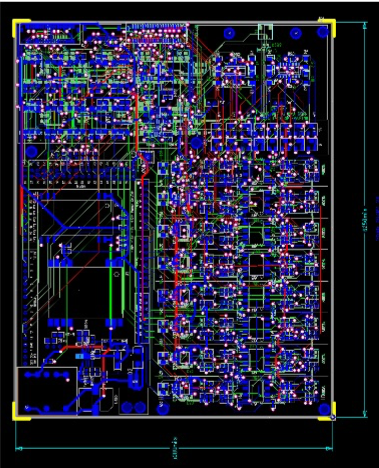
A major milestone was recently achieved in the Fortaleza antenna build! On August 22, 2023, NASA held an important meeting. The official title is the “FGO Element Design Review (EDR),” but it is known here as a delta-CDR.
That’s a lot to unpack. NASA uses Systems Engineering terminology; CDR here stands for Critical Design Review. The “delta” part of the delta-CDR means that NASA is reviewing changes put in place in the current, updated space geodesy antenna signal chain design versus the design of the previous antenna (also done by the Haystack team).
Good news: Haystack’s design passed with flying colors, with no Requests for Actions (RFAs)!
Shown here is one of the components reviewed in the delta-CDR: the layout of the upgraded VLBI Data Acquisition (VDAQ) board, updated because previously used parts are no longer available. The new board design is a single configuration versus multiple previous ones for all affected systems (which are many).
Most important is that the control and monitoring software that interfaces to all these systems will not have to be modified for this upgrade. And this is just one of many improvements in the new design. Congratulations to the entire team on achieving this successful review!
AUGUST 22, 2023—MILESTONE: DELTA-CDR (CRITICAL DESIGN REVIEW)
JULY 26, 2023
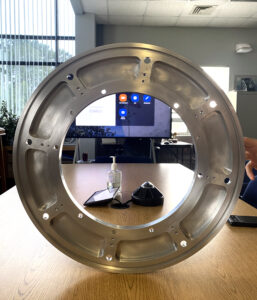
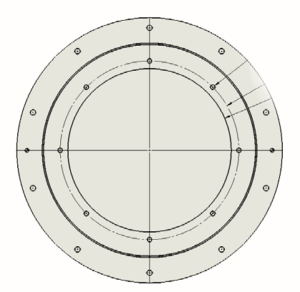
Progress continues on the Fortaleza signal chain build! One of the important component categories is the interfaces: pieces that let MIT-built components work together with components built elsewhere. As an example, the manufacturing process is now underway for something called the feed interface plate, which is what the engineers call a “mating plate” that joins the antenna, built by ISI, and the MIT-built feed. The interface between the positioner and the antenna feed cone is an opening and bolt circle to match the upper interface plate of the positioner. Once built, this piece will be shipping to the antenna vendor in early fall for a factory acceptance test (resulting in the unfortunate acronym FAT in systems engineering lingo).
JUNE 2, 2023
The next major milestone in this antenna build project is the Delta CDR, which stands for Critical Design Review, coming up in July. The “delta” means that it covers differences from the previous design used in the McDonald Observatory (MGO) antenna build in Texas. At this Delta CDR, which includes the Haystack, Fortaleza, and NASA teams and takes about half a day, the teams review together any modifications between the previous antenna design and this new and improved one. Potential examples include digital backend changes (next-generation updates and other continuous improvements) and replacements for now-unavailable components.
MAY 11, 2023
One of software engineer Violet Pfeiffer’s contributions to the Fortaleza signal chain is her work on the backend computer. This backend PC is a server that provides data to the R2DBE (ROACH digital backend), which in turn converts the analog baseband signal to a digital signal. This hardware is used in the Fortaleza antenna’s signal chain, where geodetic data is collected and processed in the NASA antennas and others all around the world for the purposes of determining time on earth, allowing the GPS (Global Positioning System) to work and enabling accurate timekeeping of UT1, or universal time, among other things. So make sure to thank Violet (and the many other people involved, of course) for helping make sure we get to the right place on time!
APRIL 20, 2023
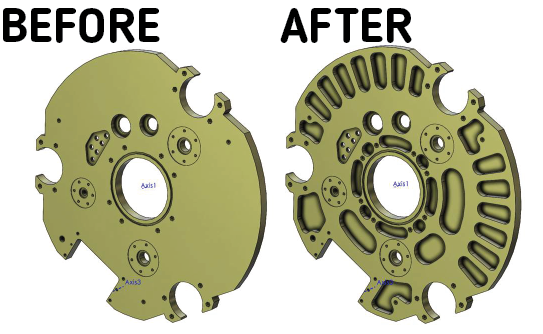
One of the interesting background aspects of our capability for improvement in the updated designs possible with successive antenna builds is the increased efficiency achieved by removing as much unnecessary weight as possible from certain components. The front end of the new Fortaleza antenna (everything from where the incoming signal enters to where the signal is separated into two frequency bands, before they are transferred to the back end equipment for processing) will be made lighter by the Haystack engineering system of removing material from machined elements. Even small weight savings can be made in this way, by shelling out or removing material in regions with low mechanical stresses—every little bit adds up and improves performance.
(If you’re interested in explanations of some of the basic technical terms in these posts, stay tuned! A series of future updates will get into definitions that non-scientists and non-engineers will appreciate, along with diagrams and photos.)
APRIL 6, 2023
R2DBEs incoming! We’ll get into some of these technical components in more detail here later, but this week we’re highlighting the contents of the R2DBEs, or ROACH-2 digital backends, five of which are fresh new arrivals at Haystack. These digital backend systems, also used in the Event Horizon Telescope black hole images, digitize and time-stamp the incoming radio signals before they are sent on to other components for recording and analysis.
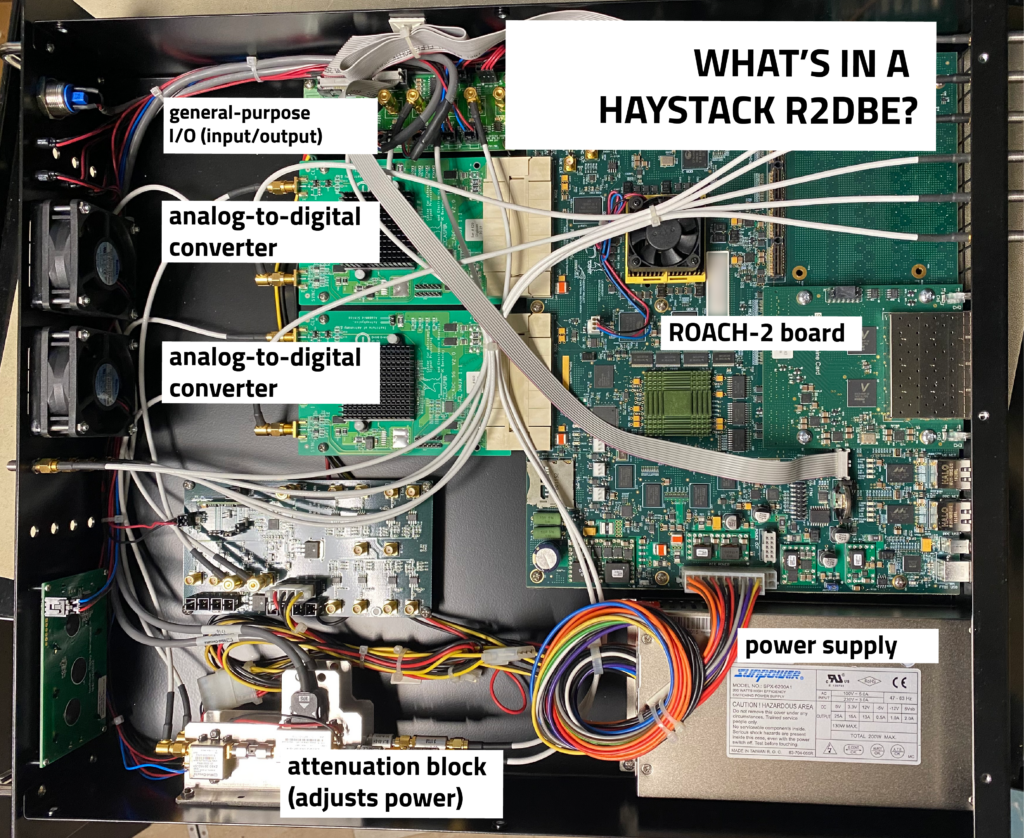
MARCH 23, 2023
It probably won’t surprise anyone that CAD is used for antenna design: for each new signal chain, the Haystack team examines past CAD diagrams and adapts them with any improvements and updated features we have designed to be incorporated into the new antenna build. The engineering teams are also reviewing the parts list in great detail and noting significant updates: some of these items have “long-lead” schedules and must be ordered very early in the process. The team is also working on compressor updates, based on analysis of past compressor performance. In addition, the R2DBEs, which are “digital back-end” systems that digitize and time-stamp the radio signals before sending them on for recording—also used in the Event Horizon Telescope historical imaging of black holes—have been shipped and will arrive at Haystack for later configuration and software installation next week.

MARCH 9, 2023
Time for a little retail therapy! The purchasing phase is underway. Granted, it’s not the most glamorous step, but this stage is of course crucial to the overall signal chain plan. Early acquisitions include a few high-powered computers and a compressor.

The compressor is an essential piece in a radio telescope’s signal chain: it is part of the cryogenics system, which cools the receiver. By reducing the temperature, the cryogenics system thus minimizes the electromagnetic “noise” that is contributed by components within the signal chain. At these extremely low temperatures—just above absolute zero—the sensitivity of a receiver is significantly increased and incredibly faint astronomical signals can be detected.
MARCH 1, 2023
GOOD TO GO! The build of the NASA SGP Fortaleza radio telescope in Brazil has been launched! So far, the Haystack signal chain design and installation teams have been doing some essential kickoff work, such as figuring out the two-year schedule down to the smallest task and assignments, making sure everyone on the team follows the documentation system and naming scheme for engineering diagrams, and putting in place a shipping system to get components to Brazil, amongst other work. Parts are being ordered and everyone is working on their starting assignments! In this blog, we’ll share their tried-and-true processes and show you what it takes to design, create, and install a top-end signal chain for a NASA radio telescope.